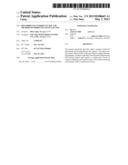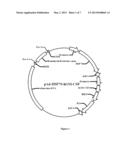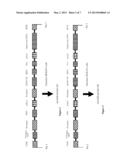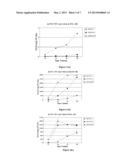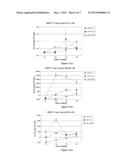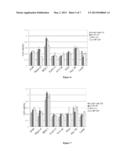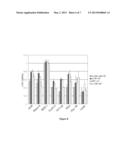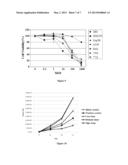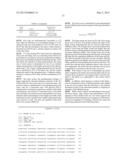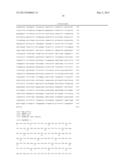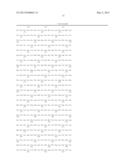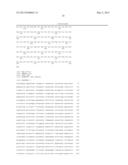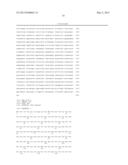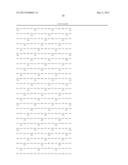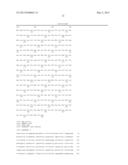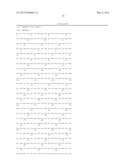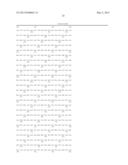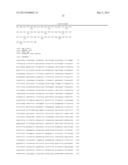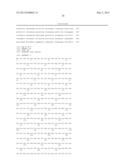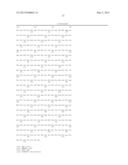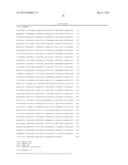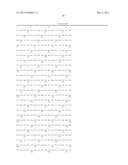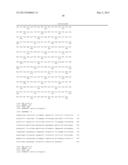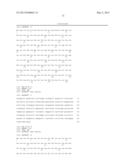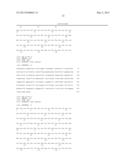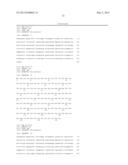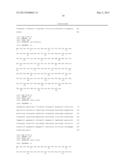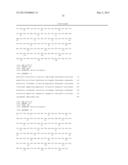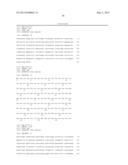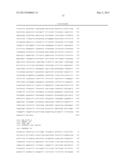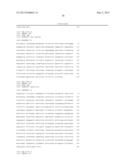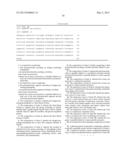Patent application title: RECOMBINANT TUMOR VACCINE AND METHOD OF PRODUCING SUCH VACCINE
Inventors:
Min Liang (Shanghai, CN)
Assignees:
TOT SHANGHAI R&D CENTER CO., LTD.
IPC8 Class: AA61K317088FI
USPC Class:
4242771
Class name: Drug, bio-affecting and body treating compositions antigen, epitope, or other immunospecific immunoeffector (e.g., immunospecific vaccine, immunospecific stimulator of cell-mediated immunity, immunospecific tolerogen, immunospecific immunosuppressor, etc.) cancer cell or component thereof
Publication date: 2013-05-02
Patent application number: 20130108665
Abstract:
The present disclosure provides tumor vaccines useful for preventing and
treating tumors and cancers. The tumor vaccines may contain nucleic acids
encoding for antigen presenting peptides, cytokines and other factors
useful for preventing and treating tumors and cancers, or expression
vectors or viruses containing such nucleic acids, or host cells
containing such nucleic acids or expression vectors.Claims:
1. A composition comprising: a first polynucleotide encoding an antigen
presenting polypeptide, a second polynucleotide encoding a cytokine, and
at least one promoter, wherein the at least on promoter is operably
linked to at least one of the first polynucleotide and the second
polynucleotide.
2. An expression vector comprising: a first polynucleotide segment encoding an antigen presenting polypeptide, a second polynucleotide segment encoding a cytokine, and at least one promoter, wherein the at least one promoter is operably linked to at least one of the first polynucleotide segment and the second polynucleotide segment.
3. The composition of claim 1, wherein the antigen presenting polypeptide is a Heat Shock Protein.
4. The composition of claim 1, wherein the Heat Shock Protein is selected from the group consisting of Hsp10, Hsp20, Hsp27, Hsp40, Hsp60, Hsp70, Hsp71, Hsp72, Hsp90, Hsp104, Hsp110, alpha-B-crystallin, and glucose-regulated protein.
5. The composition of claim 4, wherein the Heat Shock Protein is Hsp70.
6. The composition of claim 1, wherein the antigen presenting polypeptide has at least 70% sequence identity to Hsp70.
7. The composition of claim 1, wherein the cytokine is selected from the group consisting of macrophage-colony stimulating factors, granulocyte-colony stimulating factors, macrophage/granulocyte-colony stimulating factors, stem cell factors, and erythropoietin.
8. The composition of claim 1, further comprising a third polynucleotide encoding a cytokine operably linked to a promoter.
9. The composition of claim 1, wherein the first polynucleotide is operably linked to a constitutive promoter and the second polynucleotide is operably linked to a tumor specific promoter.
10. The composition of claim 1, wherein the at least one promoter is a eukaryotic promoter.
11. The composition of claim 1, wherein the at least one promoter is a tumor specific promoter.
12. The expression vector of claim 2, wherein the expression vector is selected from the group consisting of plasmid, virus, phage, and cosmid.
13. The expression vector of claim 12, wherein the expression vector is a virus vector.
14. The expression vector of claim 13, wherein the virus vector is a vector derived from one or more viruses selected from the group consisting of adenovirus, retrovirus, lentivirus, vaccinia virus, herpes simplex virus, vesicular stomatitis virus, measles virus, respiratory and enteric orphan virus, Newcastle disease virus, and Sendai virus.
15. The expression vector of claim 13, wherein the virus vector is a replication competent vector.
16. The expression vector of claim 15, wherein the virus vector is an adenovirus vector containing an E1a gene.
17. The expression vector of claim 16, wherein the E1a gene is operably linked to a tumor specific promoter.
18. An isolated host cell containing a composition of claim 1.
19. A pharmaceutical composition comprising a pharmaceutically acceptable carrier and the composition of claim 1.
20. A method of treating a cancer, comprising administering to a subject the pharmaceutical composition of claim 19.
Description:
BACKGROUND
[0001] Antigen presentation is a process in adaptive immune responses, during which antigen-presenting cells capture antigens and present the antigens on their surface for recognition by T cells. Antigens are displayed on the surface of antigen-presenting cells together with major histocompatibility complex (MHC) molecules, which can be recognized and bound by T cell receptors and thus promote antigen presentation. Once the T cells recognize the antigens presented on the cell surface, they are activated and generate immune responses against the antigens. Through antigen presentation, T cells can generate immune responses towards exogenous antigens as well as endogenous antigens.
[0002] Cytokines are important players in the immune response regulation. Cytokines are small proteins secreted by cells in the immune system that can function to transmit signals for regulating the immune system. Different cytokines can carry different signals. For example, some cytokines can stimulate proliferation or maturation of immune cells; some cytokines can direct the migration of immune cells; and some cytokines can enhance cell-based immune responses.
[0003] Cancers or tumors are believed to be associated with, at least partially, weakened or deficient immune responses to cancerous changes in people. Various therapies have been used to treat cancers including gene therapy. Gene therapy for cancer treatment may involve delivery of genes that can kill or inhibit cancer cells, genes that can enhance immune responses against cancer cells, genes that can repair or replace the mutated or altered genes, or genes that can make cancer cells more sensitive to chemotherapy or radiation therapy.
SUMMARY
[0004] The present disclosure relates to recombinant tumor vaccines useful for preventing and treating tumors and cancers. The tumor vaccines may contain nucleic acids encoding for antigen presenting peptides, cytokines and other factors useful for preventing and treating tumors and cancers, and/or expression vectors containing such nucleic acids, and/or host cells containing such nucleic acids and/or expression vectors. The present disclosure also relates to pharmaceutical compositions containing the tumor vaccines and methods of preventing and treating tumors and cancers using the tumor vaccines.
[0005] In one aspect, the present disclosure provides a recombinant tumor vaccine including a composition of a first polynucleotide encoding an antigen presenting polypeptide, a second polynucleotide encoding a cytokine, and at least one promoter, where the at least one promoter is operably linked to at least one of the first polynucleotide and the second polynucleotide.
[0006] In another aspect, the present disclosure provides a recombinant tumor vaccine including an expression vector having a first polynucleotide segment encoding an antigen presenting polypeptide, a second polynucleotide segment encoding a cytokine, and at least one promoter, where the at least on promoter is operably linked to at least one of the first polynucleotide segment and the second polynucleotide segment.
[0007] In another aspect, the present disclosure provides a pharmaceutical composition containing a pharmaceutically acceptable carrier and a tumor vaccine containing a first polynucleotide encoding an antigen presenting polypeptide, a second polynucleotide encoding a cytokine, and at least one promoter, where the at least one promoter is operably linked to at least one of the first polynucleotide and the second polynucleotide.
[0008] In another aspect, the present disclosure provides a method of treating a tumor, including administering into a subject a pharmaceutical composition containing a pharmaceutically acceptable carrier and a tumor vaccine containing a first polynucleotide encoding an antigen presenting polypeptide, a second polynucleotide encoding a cytokine, and at least one promoter, where the at least one promoter is operably linked to at least one of the first polynucleotide and the second polynucleotide.
[0009] In another aspect, the present disclosure provides a pharmaceutical composition containing a pharmaceutically acceptable carrier and a tumor vaccine containing a first polynucleotide segment encoding an antigen presenting polypeptide, a second polynucleotide segment encoding a cytokine, and at least one promoter, where the at least on promoter is operably linked to at least one of the first polynucleotide segment and the second polynucleotide segment.
[0010] In another aspect, the present disclosure provides a method of treating a tumor, including administering into a subject a pharmaceutical composition containing a pharmaceutically acceptable carrier and a tumor vaccine containing a first polynucleotide segment encoding an antigen presenting polypeptide, a second polynucleotide segment encoding a cytokine, and at least one promoter, where the at least on promoter is operably linked to at least one of the first polynucleotide segment and the second polynucleotide segment.
[0011] The foregoing summary is illustrative only and is not intended to be in any way limiting. In addition to the illustrative aspects, embodiments, and features described above, further aspects, embodiments, and features will become apparent by reference to the drawings and the following detailed description.
BRIEF DESCRIPTION OF THE FIGURES
[0012] FIG. 1 shows a schematic map of the expression vector pAd-HSP-hGM-CSF.
[0013] FIG. 2 shows a schematic map of the genome of the adenovirus Ad-HSP-hGM-CSF.
[0014] FIG. 3 shows a schematic map of the genome of the adenovirus Ad-HSP-mGM-CSF.
[0015] FIG. 4 shows the mGM-CSF expression levels determined by ELISA in B 16 cells (a), Hep3B cells (b), and Hela cells (c), which are infected with Ad-HSP-mGM-CSF under the Multiplicity of Infection (MOI) of 10, 100 and 1000, respectively.
[0016] FIG. 5 shows the hHSP70 expression levels determined by ELISA in B 16 cells (a), Hep3B cells (b), and Hela cells (c), which are infected with Ad-HSP-mGM-CSF under the MOIs of 10, 100 and 1000, respectively.
[0017] FIG. 6 shows the cytotoxic effects of Ad-HSP-hGM-CSF on different tumor cells at a multiplicity of infection at 300.
[0018] FIG. 7 shows the cytotoxic effects of Ad-HSP-hGM-CSF on different tumor cells at a multiplicity of infection at 100.
[0019] FIG. 8 shows the cytotoxic effects of Ad-HSP-hGM-CSF on different tumor cells at a multiplicity of infection at 30.
[0020] FIG. 9 shows the cytotoxicity of Ad-HSP-mGM-CSF on 7 different types of cells.
[0021] FIG. 10 shows the changes of tumor sizes in mice treated with Ad-HSP-mGM-CSF.
DETAILED DESCRIPTION
[0022] In the following detailed description, reference is made to the accompanying drawings, which form a part hereof. In the drawings, similar symbols typically identify similar components, unless context dictates otherwise. The illustrative embodiments described in the detailed description, drawings, and claims are not meant to be limiting. Other embodiments may be utilized, and other changes may be made, without departing from the spirit or scope of the subject matter presented here.
[0023] The Nucleic Acid Composition
[0024] The present disclosure relates to a recombinant tumor vaccine having a composition containing a first polynucleotide encoding an antigen presenting polypeptide, a second polynucleotide encoding a cytokine, and at least one promoter, where the at least one promoter is operably linked to at least one of the first polynucleotide and the second polynucleotide.
[0025] The term "recombinant" as used herein refers to artificial manipulation of one or more biological molecules such as polynucleotide or polypeptide molecules using one or more molecular biology techniques to make such biological molecule(s) into something other than its natural state.
[0026] The term "polynucleotide" or "nucleic acid" as used herein refers to ribonucleic acids (RNA), deoxyribonucleic acids (DNA), or mixed ribonucleic acids-deoxyribonucleic acids such as DNA-RNA hybrids. The polynucleotide or nucleic acid may be single stranded or double stranded DNA or RNA or DNA-RNA hybrids. The polynucleotide or nucleic acid may be linear or circular.
[0027] The term "encoding" or "encoding for" as used herein refers to being capable of being transcribed into mRNA and/or translated into a peptide or protein. An "encoding sequence" or a "gene" refers to a polynucleotide sequence that encodes for an mRNA, a peptide or a protein. These two terms are used interchangeably in the present disclosure.
[0028] The term "mRNA" as used herein refers to a RNA molecule that is complementary to a template DNA sequence, and can serve as the template for protein synthesis.
[0029] The term "antigen presenting polypeptide" as used herein refers to a polypeptide or a protein that can bind to an antigen, present the antigen to the antigen presenting cell and facilitate the recognition of the antigen by an antigen presenting cell.
[0030] The term "antigen presenting cell" as used herein refers to a cell that is capable of displaying an antigen with major histocompatibility complex (MHC) on its surface, in such a way that T cells can recognize the displayed antigen. The displayed antigen can be recognized by immune cells such as T cells which consequently generate an immune response against the antigen. In certain embodiments, the antigen presenting cells are dendritic cells, macrophages, B-cells or epithelia cells. In an illustrative embodiment, the antigen presenting cells are dendritic cells.
[0031] The term "operably linked" as used herein refers to that the encoding sequence is directly or indirectly linked to or associated with one or more regulatory sequences in a manner that allows expression of the encoding sequence.
[0032] The term "expression" as used herein refers to transcription of an encoding sequence into mRNA and/or translation of an encoding sequence into a peptide or protein.
[0033] The term "transcription" as used herein refers to the process of RNA synthesis where a DNA sequence is read by a RNA polymerase to produce a RNA chain complementary to the DNA sequence.
[0034] The term "translation" as used herein refers to the process of peptide or protein synthesis where an mRNA sequence is read by a ribosome to produce an amino acid chain according to the amino acid codons contained in the mRNA sequence.
[0035] The term "regulatory sequence" as used herein refers to any nucleotide sequence that is necessary or advantageous for the expression of an encoding sequence. A regulatory sequence may include, but is not limited to, one or more promoters, enhancers, transcription terminators, polyadenylation sequences, and internal ribosome entry sites.
[0036] The term "promoter" as used herein refers to a polynucleotide sequence that can control transcription of an encoding sequence. The promoter sequence includes specific sequences that are sufficient for RNA polymerase recognition, binding and transcription initiation. In addition, the promoter sequence may include sequences that modulate this recognition, binding and transcription initiation activity of RNA polymerases. The promoter may affect the transcription of a gene located on the same nucleic acid molecule as itself or a gene located on a different nucleic acid molecule as itself. Functions of the promoter sequences, depending upon the nature of the regulation, may be constitutive or inducible by a stimulus. A "constitutive" promoter refers to a promoter that functions to continually activate gene expression in host cells. An "inducible" promoter refers to a promoter that activates gene expression in host cells in the presence of certain stimulus or stimuli.
[0037] The term "enhancer" as used herein refers to a nucleotide sequence that increases the transcription and/or translation of the encoding sequence. The enhancer may be operably linked to the 5' terminus or 3' terminus of an encoding sequence. Any enhancer that is functional in eukaryotic cells may be used in the present disclosure. Illustrative examples of enhancers include, without limitation, the simian virus 40 (SV40) early gene enhancer, the enhancer derived from the long terminal repeat (LTR) of Rous Sarcoma virus, and the enhancer derived from human cytomegalovirus (CMV).
[0038] The term "transcription terminator" as used herein refers to a nucleotide sequence recognized by a eukaryotic cell RNA polymerase to terminate transcription. The terminator sequence may be operably linked to the 3' terminus of an encoding sequence. In certain embodiments, the terminator may comprise a signal for the cleavage of the RNA such that a polyadenylation site on the RNA can be exposed. Any terminator sequence that is functional in eukaryotic cells may be used in the present disclosure. Illustrative examples of terminator sequences include, without limitation, termination sequences derived from a virus such as the SV40 terminator, and termination sequences derived from known genes such as the bovine growth hormone terminator sequence.
[0039] The term "polyadenylation sequence" as used herein refers to a nucleotide sequence which, when transcribed, is recognized by eukaryotic cells as a signal to add polyadenosine residues to the transcribed mRNA. The polyadenylation sequence may be operably linked to the 3' terminus of an encoding sequence. Any polyadenylation sequence which is functional in eukaryotic cells may be used in the present disclosure. Illustrative examples of polyadenylation sequences include, without limitation, AAUAAA, and SV40 polyadenylation signal.
[0040] The term "internal ribosome entry site" (IRES), as used herein refers to a nucleotide sequence which allows translation initiation from the middle of an mRNA sequence. IRES can be used to separate two or more encoding sequences on one polynucleotide molecule so as to allow separate translation of the two or more encoded products. IRES may be operably linked at a position after the 3' terminus of a first encoding sequence and before the 5' terminus of a second encoding sequence. Any IRES sequence which is functional in eukaryotic cells may be used in the present disclosure. Illustrative examples of IRES may include, without limitation, picornavirus IRES, pestivirus IRES, aphthovirus IRES, hepatitis A IRES, and hepatitis C IRES.
[0041] The present disclosure provides a composition containing a first polynucleotide encoding an antigen presenting polypeptide and a second polynucleotide encoding a cytokine. In certain embodiments, the first polynucleotide and the second polynucleotide are on different nucleic acid molecules. In certain embodiments, the first polynucleotide and the second polynucleotide are on the same nucleic acid molecules. In certain embodiments, a single promoter controls the expression of the first polynucleotide and the second polynucleotide. In certain embodiments, different promoters control the expression of the first polynucleotide and the second polynucleotide.
[0042] In certain embodiments, the first polynucleotide and the second polynucleotide are operably linked to one promoter, which controls the expression of the first and second polynucleotide, and in which the first polynucleotide segment and the second polynucleotide segment are separated by an IRES sequence.
[0043] In certain embodiments, the first polynucleotide is operably linked to a first promoter that controls the expression of the first polynucleotide, and the second polynucleotide is operably linked to a second promoter that controls the expression of the second polynucleotide. The first promoter and the second promoter can be the same or different.
[0044] In certain embodiments, the promoters of the present disclosure are eukaryotic promoters such as the promoters from CMV (e.g. the CMV immediate early promoter (CMV promoter)), epstein barr virus (EBV) promoter, human immunodeficiency virus (HIV) promoter (e.g. the HIV long terminal repeat (LTR) promoter), moloney virus promoter, mouse mammary tumor virus (MMTV) promoter, rous sarcoma virus (RSV) promoter, SV40 early promoter, promoters from human genes such as human myosin promoter, human hemoglobin promoter, human muscle creatine promoter, human metalothionein beta-actin promoter, human ubiquitin C promoter (UBC), mouse phosphoglycerate kinase 1 promoter (PGK), human thymidine kinase promoter (TK), human elongation factor 1 alpha promoter (EF1A), cauliflower mosaic virus (CaMV) 35S promoter, E2F-1 promoter (promoter of E2F1 transcription factor 1), promoter of alpha-fetoprotein, promoter of cholecystokinin, promoter of carcinoembryonic antigen, promoter of C-erbB2/neu oncogene, promoter of cyclooxygenase, promoter of CXC-Chemokine receptor 4 (CXCR4), promoter of human epididymis protein 4 (HE4), promoter of hexokinase type II, promoter of L-plastin, promoter of mucin-like glycoprotein (MUC1), promoter of prostate specific antigen (PSA), promoter of survivin, promoter of tyrosinase related protein (TRP1), and promoter of tyrosinase.
[0045] In certain embodiments, the promoters of the present disclosure may be tumor specific promoters. The term "tumor specific promoter" as used herein refers to a promoter that functions to activate gene expression preferentially or exclusively in tumor cells, and has no activity or reduced activity in non-tumor cells or non-cancer cells. Illustrative examples of tumor specific promoters include, without limitation, E2F-1 promoter, promoter of alpha-fetoprotein, promoter of cholecystokinin, promoter of carcinoembryonic antigen, promoter of C-erbB2/neu oncogene, promoter of cyclooxygenase, promoter of CXCR4, promoter of HE4, promoter of hexokinase type II, promoter of L-plastin, promoter of MUC1, promoter of PSA, promoter of survivin, promoter of TRP1, and promoter of tyrosinase. In certain embodiments, the promoter of the present disclosure is E2F-1. In certain embodiments, the E2F-1 promoter has a nucleotide sequence of SEQ ID NO: 29.
[0046] The first promoter and/or second promoter described above may be a constitutive promoter. In certain embodiments, the constitutive promoter can be a promoter of house-keeping genes which are required for fundamental cellular functions. Illustrative examples include, without limitation, promoter of beta-actin promoter, UBC promoter, PGK promoter, TK promoter, and EF1A promoter. In certain embodiments, the constitutive promoter can be a viral promoter. Illustrative examples include, without limitation, CMV promoter, SV40 promoter, and CaMV 35S promoter.
[0047] In certain embodiments, the recombinant nucleic acid composition of the present disclosure contains a first polynucleotide encoding an antigen presenting polypeptide that is controlled by a constitutive promoter such as CMV promoter, and a second polynucleotide encoding a cytokine that is controlled by a tumor specific promoter such as E2F-1 promoter.
[0048] In certain embodiments, the antigen presenting polypeptides are heat shock proteins. The heat shock proteins are a family of proteins whose expression are increased when cells are exposed to elevated temperatures or other stress. Heat shock proteins are known to play an important role in folding the proteins to make a proper conformation. In addition, heat shock proteins are found to present protein fragments to the immune system.
[0049] Any heat shock protein may be used as the antigen presenting polypeptide for the present disclosure. Illustrative examples of heat shock proteins include, without limitation, Hsp10, Hsp20, Hsp27, Hsp40, Hsp60, Hsp70, Hsp71, Hsp72, Hsp90, Hsp104, Hsp110, alpha-B-crystallin, and glucose-regulated proteins.
[0050] In certain embodiments, the antigen presenting polypeptide is Hsp70. Hsp70 proteins include, without limitation, Hsp70-1, Hsp70-2, Hsp70-4, Hsp70-5, Hsp70-6, Hsp70-7, Hsp70-8, Hsp70-9, Hsp70-12, and Hsp70-14. In certain embodiments, the antigen presenting polypeptide is Hsp70-1. Hsp70-1 proteins include, without limitation, Hsp 70-1A, and Hsp 70-1B.
[0051] In certain embodiments, the antigen presenting polypeptide is Hsp90. Hsp90 proteins include, without limitation, Hsp90-α1, Hsp90-α2, Hsp90-β, endoplasmin, and TNF receptor-associated protein 1.
[0052] In certain embodiments, the antigen presenting polypeptide is glucose-regulated protein. The glucose-regulated protein include, without limitation, glucose-regulate protein 75 (Grp75, also known as Hsp70-9), Grp78 (also known as Hsp70-5), Grp94 (also known as endoplasmin), and Grp170.
[0053] Illustrative examples of heat shock proteins and their GenBank accession numbers are listed in Table 1.
TABLE-US-00001 TABLE 1 Examples of heat shock proteins Nucleotide sequence Peptide sequence GenBank SEQ ID GenBank SEQ ID Species Name Accession No. NOs Accession No. NOs Homo sapiens HSP70 NM_005345.5 SEQ ID NP_005336.3 SEQ ID (Human) 1A NO: 1 NO: 2 Homo sapiens Hsp70-4 NM_002154.3 SEQ ID NP_002145.3 SEQ ID (Human) NO: 3 NO: 4 Homo sapiens Hsp90 α NM_001017963.2 SEQ ID NP_001017963.2 SEQ ID (Human) isoform 1 NO: 5 NO: 6 Homo sapiens Grp-75 NM_004134.6 SEQ ID NP_004125.3 SEQ ID (Human) NO: 7 NO: 8 Mus musculus Grp-78 NM_022310.3 SEQ ID NP_071705.3 SEQ ID (house mouse) NO: 9 NO: 10 Rattus norvegicus alpha- NM_012935.3 SEQ ID NP_037067.1 SEQ ID (Norway rat) crystallin NO: 11 NO: 12 B chain
[0054] In certain embodiments, the antigen presenting polypeptides of the present disclosure is a fragment of a full length heat shock protein that retains the function of presenting antigens to the antigen presenting cells. In certain embodiments, the antigen presenting polypeptides of the present disclosure is a functional equivalent of a naturally occurring antigen presenting polypeptide. The functional equivalent is structurally homologous to the naturally occurring antigen presenting polypeptide and can function to present antigens to the antigen presenting cells. A functional equivalent of a naturally occurring antigen presenting polypeptide may have one or more conservative or non-conservative amino acid substitutions, additions, deletions, modifications or other changes to a naturally occurring antigen presenting polypeptide sequence.
[0055] In certain embodiments, the antigen presenting polypeptides of the present disclosure share peptide sequence identity with one or more heat shock proteins. The term "peptide sequence identity" as used herein refers to the amino acid residues in a candidate sequence that are identical with the amino acid residues in the template sequence, after aligning the sequences and introducing gaps, if necessary, to achieve the maximum number of identical amino acid residues between the candidate sequence and the template sequence, and not considering any conservative substitutions as part of the sequence identity.
[0056] Identity of two amino acid sequences may be determined by aligning the two amino acid sequences. Publicly available computer softwares may be used in the alignment, such as BLAST, BLAST-2, ALIGN or Megalign (DNASTAR) software. Those skilled in the art can determine appropriate parameters for measuring alignment, including any algorithms needed to achieve maximal alignment over the full length of the sequences being compared.
[0057] In certain embodiments, the antigen presenting polypeptide has at least 50%, or at least 60%, or at least 70%, or at least 80%, or at least 90%, or at least 95%, or at least 97%, or at least 99% peptide sequence identity with one of Hsp10, Hsp20, Hsp27, Hsp40, Hsp60, Hsp70, Hsp71, Hsp72, Hsp90, Hsp104, Hsp110, alpha-B-crystallin, and glucose-regulated proteins.
[0058] In certain embodiments, the antigen presenting polypeptide has at least 50%, or at least 60%, or at least 70%, or at least 80%, or at least 90%, or at least 95%, or at least 97%, or at least 99% peptide sequence identity with Hsp70.
[0059] In certain embodiments, the antigen presenting polypeptide contains one or more functional domains from one or more heat shock proteins. The term "functional domain" as used herein refers to a part of a heat shock protein that has the function of presenting antigens to the antigen presenting cells, which function is independent of the rest of the protein sequence and structure. In certain embodiments, the antigen presenting polypeptide contains one or more functional domains derived from one or more heat shock proteins selected from the group consisting of Hsp10, Hsp27, Hsp40, Hsp60, Hsp70, Hsp71, Hsp72, Hsp90, Hsp104, alpha-B-crystallin, and glucose-regulated protein.
[0060] In certain embodiments, the nucleic acid composition contains one or more polynucleotides encoding one or more heat shock proteins. In certain embodiments, a polynucleotide of the present disclosure may encode for one, two, three or four heat shock proteins. In certain embodiments, the composition of the present disclosure contains one, two, three, or four polynucleotides, each of which encodes for a heat shock protein. In certain embodiments, the composition contains a polynucleotide encoding for two or more heat shock proteins.
[0061] The term "cytokine" as used herein refers to a protein or polypeptide that is secreted by cells and has immunomodulating effects, such as, stimulating the functions of immune cells, promoting growth of immune cells, or directing immune cells to a local site in need.
[0062] Any suitable cytokines may be used for the present disclosure. Illustrative examples of cytokines include, without limitation, colony-stimulating factors such as granulocyte macrophage colony-stimulating factors (GM-CSFs), macrophage-colony stimulating factors (M-CSFs), granulocyte-colony stimulating factors (G-CSFs), stem cell factors, and erythropoietin; interferons (IFNs) such as IFN α, IFN β, IFN γ, and IFN ω; interleukins such as IL-1, IL-2, IL-3, IL-4, IL-5, IL-6, IL-7, IL-8, IL-9, IL-10, IL-11, IL-12, IL-13, IL-14, IL-15, IL-16, IL-17, IL-18, IL-19, IL-20, IL-21, IL-22, IL-23, IL-24, IL-25, IL-26, IL-27, IL-28, IL-29, IL-30, IL-31, IL-32, IL-33, and IL-35; tumor necrosis factors (TNFs) such as TNF α, and TNF β; chemokines such as CCL1, CCL2, CCL3, CCL4, CCL5, CCL6, CCL7, CCL8, CCL9, CCL10, CCL11, CCL12, CCL13, CCL14, CCL15, CCL16, CCL17, CCL18, CCL19, CCL20, CCL21, CCL22, CCL23, CCL24, CCL25, CCL26, CCL27, CCL28, CXCL1, CXCL2, CXCL3, CXCL4, CXCL5, CXCL6, CXCL7, CXCL8, CXCL9, CXCL10, CXCL11, CXCL12, CXCL13, CXCL14, CXCL15, CXCL16, CXCL17, XCL1, XCL2, and CX3L1.
[0063] In certain embodiments, the cytokines of the present disclosure can stimulate the function and/or accumulation of antigen presenting cells. In certain embodiments, the cytokines include M-CSFs, G-CSFs, GM-CSFs, stem cell factors, and erythropoietin. In certain embodiments, the cytokines of the present disclosure are GM-CSFs. Illustrative examples of GM-CSFs and their GenBank accession numbers are listed in Table 2.
TABLE-US-00002 TABLE 2 Examples of GM-CSFs Nucleotide sequence Peptide sequence GenBank SEQ ID GenBank SEQ ID Species Name Accession No. NOs Accession No. NOs Homo sapiens GM-CSF M11220.1 SEQ ID AAA52578.1 SEQ ID (Human) NO: 13 NO: 14 Homo sapiens GM-CSF BC113924.1 SEQ ID AAI13925.1 SEQ ID (Human) NO: 15 NO: 16 Mus musculus GM-CSF X03019.1 SEQ ID CAA26820.1 SEQ ID (house mouse) NO: 17 NO: 18 Mus musculus GM-CSF EU366957.1 SEQ ID ABY66391.1 SEQ ID (house mouse) NO: 19 NO: 20 Felis catus GM-CSF AF053007.1 SEQ ID AAC06041.1 SEQ ID (domestic cat) NO: 21 NO: 22 Rattus norvegicus GM-CSF U00620.1 SEQ ID AAA18281.1 SEQ ID (Norway rat) NO: 23 NO: 24 Homo sapiens GM-CSF AC004511.1 SEQ ID AAC08707.1 SEQ ID (Human) NO: 25 NO: 26
[0064] In certain embodiments, the cytokine of the present disclosure is a fragment of a cytokine that retains its function of immunomodulating effects.
[0065] In certain embodiments, the cytokines of the present disclosure share peptide sequence identity with one or more cytokines. In certain embodiments, the cytokine encoded by the second polynucleotide has at least 50%, or at least 60%, or at least 70%, or at least 80%, or at least 90%, or at least 95%, or at least 97%, or at least 99% peptide sequence identity with one or more of M-CSFs, G-CSFs, GM-CSFs, stem cell factors, and erythropoietin.
[0066] In certain embodiments, the cytokine encoded by the second polynucleotide has at least 50%, or at least 60%, or at least 70%, or at least 80%, or at least 90%, or at least 95%, or at least 97%, or at least 99% peptide sequence identity with GM-CSFs.
[0067] In certain embodiments, the cytokine contains one or more functional domains from one or more cytokines. In certain embodiments, the antigen presenting polypeptide contains one or more functional domains derived from one or more cytokines selected from the group of M-CSFs, G-CSFs, GM-CSFs, stem cell factors, and erythropoietin.
[0068] In certain embodiments, the nucleic acid composition contains one or more polynucleotides encoding one or more cytokines. In certain embodiments, a polynucleotide of the present disclosure may encode for one, two, three or four cytokines. In certain embodiments, the composition of the present disclosure contains one, two, three, or four polynucleotides, each of which encodes for a cytokine. In certain embodiments, the composition contains a polynucleotide encoding for two or more cytokines.
[0069] In certain embodiment, the composition further contains a third polynucleotide encoding for a cell toxic gene. The term "cell toxic gene" as used herein refers to a gene that can function to induce or enhance cytotoxicity including cell death. In certain embodiments, a cell toxic gene can improve cell susceptibility to lysis by other cells such as macrophages. Illustrative examples of the cell toxic genes include, without limitation, thymidine kinase gene, and cytosine deaminase gene.
[0070] The third polynucleotide may be operably linked to a promoter. In certain embodiments, the expression of the first polynucleotide, the second polynucleotide and the third polynucleotide is controlled by the same promoter. In certain embodiments, the expression of two of the first, second and third polynucleotide is controlled by the same promoter. In certain embodiments, one or more IRES sequence are used to separate the encoding sequences on the same polynucleotide molecule such that the encoded products can be separately translated and expressed from the polynucleotide molecule.
[0071] In certain embodiments, different promoters control the expression of the first polynucleotide, the second polynucleotide and the third polynucleotide. In certain embodiments, the first polynucleotide is operably linked to a first promoter, the second polynucleotide is operably linked to a second promoter, and the third polynucleotide is operably linked to a third promoter. In certain embodiments, the first, second and/or third promoters are eukaryotic promoters. In certain embodiments, the first, second and/or third promoters are constitutive promoters. In certain embodiments, the first, second and/or third promoters are tumor specific promoters. In certain embodiments, at least one of the first, second and third promoters are tumor specific promoters. In certain embodiments, at least two of the first, second and third promoters are tumor specific promoters. In certain embodiments, all of the first, second and third promoters are tumor specific promoters.
[0072] The nucleic acid sequences of the present disclosure are available publicly or may be readily obtained by a person skilled in the art. The polynucleotides or nucleic acids of the present disclosure can be made through well known recombinant techniques in the art (see, for example, Sambrook et al. Molecular Cloning: A Laboratory Manual (Cold Spring Harbor Laboratory, N.Y. (1989), which is incorporated herein by reference in its entirety).
[0073] The Expression Vector
[0074] The polynucleotides described above may be inserted into one or more expression vectors. The present disclosure provides an expression vector containing a first polynucleotide segment encoding an antigen presenting polypeptide, a second polynucleotide segment encoding a cytokine, and at least one promoter, wherein the at least one promoter is operably linked to at least one of the first polynucleotide segment and the second polynucleotide segment.
[0075] The term "expression vector" as used herein refers to a polynucleotide vehicle capable of transforming or transfecting cells and allowing gene expression in the cells. The term "segment" as used herein refers to a portion or a fragment of a nucleic acid sequence.
[0076] The expression vectors of the present disclosure may be viral vectors, plasmids, phages or cosmids. In certain embodiments, the expression vectors of the present disclosure may further comprise one or more gene sequences derived from a virus, a plasmid, a phage or a cosmid or fragments thereof.
[0077] In certain embodiments, the expression vectors of the present disclosure are viral vectors. Viral vectors can contain the whole or a portion of a viral genome. In certain embodiment, a viral vector contains the whole or a portion of the viral genome of two or more viruses.
[0078] In certain embodiments, the viral vector is derived from an adenovirus. Adenovirus has a double-strand linear DNA genome which can not be integrated into the host genome. Illustrative examples of adenovirus vectors include, without limitation, first generation adenovectors (e.g., adenovector having E1a and E1b genes deleted, and adenovector having E1 and E3 genes deleted), second generation adenoviral vectors (e.g. adenovector having E1 and E2 genes deleted, adenovector having E1 and E4 genes deleted), and gutless adenoviral vectors in which all viral coding sequences are deleted (also called helper dependent adenoviral vector).
[0079] In certain embodiments, the viral vector is derived from an adeno-associated virus (AAV). Adeno-associated virus can infect both dividing and non-dividing cells and can integrate its genome to that of the host cells. Illustrative examples of adeno-associated virus vectors include, without limitation, vectors derived from AAV serotype 1, AAV serotype 2, AAV serotype 3, AAV serotype 4, AAV serotype 5, AAV serotype 6, AAV serotype 7, AAV serotype 8, AAV serotype 9, AAV serotype 10, AAV serotype 11, and AAV serotype 12.
[0080] In certain embodiments, the viral vector is derived from a retrovirus. A retrovirus has a RNA genome and can replicate in a host cell via reverse transcriptase to produce DNA from the RNA genome. Illustrative examples of retrovirus vectors include, without limitation, vectors derived from avian leucosis virus, mouse mammary tumour virus, murine leukaemia virus, bovine leukaemia virus, Walleye dermal sarcoma virus, HIV-1 (Human Immunodeficiency Virus), HIV-2, SIV (simian immunodeficiency virus), EIAV (equine infectious anaemia virus), FIV (feline immunodeficiency virus), CAEV (caprine arthritis encephalitis virus), VMV (visna/maedi virus), human spumavirus, moloney murine leukaemia virus, rous sarcoma virus, feline leukemia virus, human T-lymphotropic virus, and simian foamy virus.
[0081] In certain embodiments, the viral vector is derived from a lentivirus. Illustrative examples of lentivirus vectors include, without limitation, vectors derived from HIV-1, SIV, FIV, CAEV, VMV, and EIAV.
[0082] In certain embodiments, the viral vector is derived from an alphavirus. Illustrative examples of alphavirus vectors include, without limitation, vectors derived from venezuelan equine encephalitis virus, sindbis virus, semliki forest virus, eastern equine encephalitis virus, western equine encephalitis virus, O'nyong'nyong virus, chikungunya virus, mayaro virus, ross river virus, and barmah forest virus.
[0083] In certain embodiments, the vector is derived from a poxvirus. Illustrative examples of poxvirus vectors include, without limitation, vectors derived from vaccinia virus, variola virus, vaccinia virus, avipox virus, cowpox virus, monkeypox virus, smallpox, orf virus, pseudocowpox, bovine papular stomatitis virus, tanapox virus, yaba monkey tumor virus, and molluscum contagiosum virus.
[0084] In certain embodiments, the vector is derived from a herpesvirus. Illustrative examples of Herpesvirus vectors include, without limitation, vectors derived from herpes simplex virus-1 (HSV-1), herpes simplex virus-2, varicella zoster virus, Epstein-Barr virus (EBV), lymphocryptovirus, CMV, herpes lymphotropic virus, roseolovirus, and Kaposi's sarcoma-associated herpesvirus (KSHV).
[0085] In certain embodiments, the vector is derived from a poliovirus. Illustrative examples of poliovirus vectors include, without limitation, vectors derived from poliovirus serotype 1 (PV1), PV2, and PV3.
[0086] In certain embodiments, the expression vector is derived from a baculovirus. Illustrative examples of baculovirus vectors include, without limitation, expression vectors derived from autographa californica multicapsid nucleopolyhedrovirus (AcMNPV), orgyia pseudotsugata multicapsid polyhedrosis virus (OpMNPV), lymantria dispar multicapsid nuclear polyhedrosis virus (LdMNPV), bombyx mori nuclear polyhedrosis virus (BmNPV), choristoneura fumiferana nuclear polyhedrosis virus (CfMNPV), cryptophlebia leucotreta granulosis virus (ClGV), heliothis zea nuclear polyhedrosis virus (HzSNPV), and cydia pomonella granulosis virus (CpGV).
[0087] In certain embodiments, the expression vector is derived from a papillomavirus. Illustrative examples of papillomavirus vectors include, without limitation, vectors derived from bovine papillomavirus type 4, bovine papillomavirus type 2, human papillomavirus type 11, human papillomavirus type 5b, human papillomavirus type 6b, bovine papillomavirus type 1, cottontail rabbit papillomavirus (CRPV), deer papillomavirus (DPV), human papillomavirus type 13, and human papillomavirus type 16.
[0088] In certain embodiments, the expression vector is derived from a polyomavirus. Illustrative examples of the polyomavirus vector include, without limitation, vectors based on budgerigar fledgling disease virus (BFPyV), simian virus 40 (SV40), BK polyomavirus (BKPyV), bovine polyomavirus (BPyV), hamster polyomavirus (HaPyV), JC polyomavirus (JCPyV) (JCV), murine polyomavirus (MPyV), and B-lymphotropic polyomavirus (LPV).
[0089] In certain embodiments, the expression vector is derived from a parvovirus. Illustrative examples of parvovirus vectors include, without limitation, expression vectors derived from canine parvovirus, feline panleukopenia virus (FPV), hamster parvovirus H1, mink enteritis virus (MEV), murine minute virus (MVM), parvovirus LuIII, and porcine parvovirus (PPV).
[0090] In certain embodiments, the viral vector is derived from a measles virus. In certain embodiments, the viral vector is derived from a vesicular stomatitis virus (VSV). In certain embodiments, the viral vector is derived from a respiratory and enteric orphan virus (REO virus). In certain embodiments, the viral vector is derived from a Newcastle disease virus. In certain embodiments, the viral vector is derived from a Sendai virus (SeV).
[0091] In certain embodiments, the viral vector is a vector derived from one or more viruses selected from the group consisting of adenovirus, retrovirus, lentivirus, vaccinia virus, HSV, VSV, measles virus, REO virus, Newcastle disease virus, and SeV.
[0092] In certain embodiments, the viral vector is capable of cell lysis. Cell-lytic viral vectors can replicate in the host cells, and assemble into viral particles which are released from the cell by lysis of the host cell. Illustrative examples of cell-lytic virus vectors include, without limitation, vectors derived from adenovirus, retrovirus, lentivirus, vaccinia virus, HSV, VSV, measles virus, REO virus, Newcastle disease virus, and SeV.
[0093] In certain embodiments, the viral vector contains a tumor specific promoter for expression of the viral genes upon infection of tumor cells.
[0094] In certain embodiments, the expression vector is a plasmid. Illustrative examples of the plasmid vector include, without limitation, pBR322, pTZ19R, pUC18, pUC19, pUC57, pCMV-Script system, and pcDNA3.
[0095] In certain embodiments, the expression vector is a phage vector. Illustrative examples of the phages include, without limitation, T4 phage, lambda phage, T7 phage, p1 phage, pBlueScript II phagemid, and pBC phagemid.
[0096] In certain embodiments, the expression vector is a cosmid vector. Illustrative examples of the cosmid vector include, without limitation, SuperCos 1 vector, pJC81, and pHS262.
[0097] The expression vectors of the present disclosure may be transient expression vectors that do not integrate into the genome of the host cells or stable expression vectors that can integrate its genes into the genome of a host cell after introduction into the host cell.
[0098] In certain embodiments, the expression vector is a transient expression vector. As the host cell divides, the transient expression vectors are diluted in the host cells, and thus provide expression of exogenous genes only for a limited time. Illustrative examples of transient expression vectors include, without limitation, adenovirus vectors, herpesvirus vectors, poxvirus vectors, non-integrating plasmids or phages.
[0099] In certain embodiments, the expression vector is a stable expression vector. The stable expression vector can integrate into the host genome at any random sites or at certain designated sites. The integrated genes can replicate along with the host genome, and thus allow stable expression of the genes in the host cells. Illustrative examples of stable expression vectors include, without limitation, vectors derived from retrovirus, lentivirus, adeno-associated virus, and integrating plasmids.
[0100] The expression vectors of the present disclosure can be replication competent vectors or replication defective vectors. In certain embodiments, the expression vectors are replication competent vectors. The term "replication competent vector" as used herein refers to a vector that contains the sequence(s) necessary for self replication and can replicate by itself (without integrating into the host genome) in a host cell. In certain embodiments, the replication competent vectors can selectively or conditionally replicate in certain specific host cells, such as, tumor cells.
[0101] In certain embodiments, the replication competent vectors may be virus vectors. Illustrative examples of replication competent virus vectors include, without limitation, vectors derived from adenovirus, vaccinia virus, HSV, VSV, measles virus, REO virus, Newcastle disease virus and SeV. In certain embodiments, the replication competent viral vectors contain viral genes essential for virus replication. For example, a replication competent adenovirus vector contains the E1a gene of the adenovirus. In certain embodiments, the E1a gene is operably linked to a tumor specific promoter. In certain embodiments, the E1a gene of adenovirus has a nucleotide sequence of SEQ ID NO: 30.
[0102] In certain embodiments, the expression vector can be a replication defective vector. The term "replication defective vector" as used herein refers to a vector that cannot replicate by itself in a host cell. In certain embodiments, the replication defective vector can be a virus vector. Illustrative examples of replication defective virus vectors include, without limitation, adenovirus vectors that lack or are defective in E1a gene function.
[0103] In certain embodiments, an expression vector of the present disclosure contains a first polynucleotide segment encoding for an antigen presenting peptide, where the antigen presenting peptide is a heat shock protein. In certain embodiments, the expression vector further contains a second polynucleotide segment encoding for a cytokine, where the cytokine is a GM-CSF. In certain embodiments, the expression vector contains one or more promoters operably linked to the first and/or second polynucleotide segments.
[0104] In certain embodiments, the promoters operably linked to the first and/or second polynucleotide segments of the expression vector are eukaryotic promoters. In certain embodiments, the promoters are constitutive promoters such as the beta-actin promoter, UBC promoter, PGK promoter, TK promoter, EF1A promoter, CMV promoter, SV40 promoter, and CaMV 35S promoter. In certain embodiments, the promoters are tumor specific promoters such as the E2F-1 promoter, promoter of alpha-fetoprotein, promoter of cholecystokinin, promoter of carcinoembryonic antigen, promoter of C-erbB2/neu oncogene, promoter of cyclooxygenase, promoter of CXCR4, promoter of HE4, promoter of hexokinase type II, promoter of L-plastin, promoter of MUC1, promoter of PSA, promoter of survivin, promoter of TRP1, and promoter of tyrosinase.
[0105] In certain embodiments, the expression of the first polynucleotide segment and the second polynucleotide segment is controlled by the same promoter. In certain embodiments, the first polynucleotide segment and the second polynucleotide segment are operably linked to one promoter, in which the first polynucleotide segment and the second polynucleotide segment are separated by an IRES sequence.
[0106] In certain embodiments, the expression of the first polynucleotide segment and the second polynucleotide segment are controlled by different promoters. In certain embodiments, the first polynucleotide segment is operably linked to a first promoter, and the second polynucleotide segment is operably linked to a second promoter. In certain embodiments, the first promoter is a constitutive promoter and the second promoter is a tumor specific promoter. In certain embodiments, the first promoter is a tumor specific promoter and the second promoter is a constitutive promoter. In certain embodiments, the first and second promoters are both tumor specific promoters.
[0107] In certain embodiment, the expression vector further contains a third polynucleotide segment encoding for a cell toxic gene. The third polynucleotide segment may be operably linked to a promoter. In certain embodiments, the expression of the first polynucleotide segment, the second polynucleotide segment and the third polynucleotide segment is controlled by the same promoter. In certain embodiments, the expression of at least two of the first, second and third polynucleotide segments is controlled by the same promoter. In certain embodiments, the expression of the first polynucleotide segment and the third polynucleotide segment is controlled by the same promoter. In certain embodiments, the expression of the second polynucleotide segment and the third polynucleotide segment is controlled by the same promoter. In certain embodiments, one or more IRES sequences are used to separate the encoding sequences on the same polynucleotide molecule such that the encoded products can be separately translated and expressed from the polynucleotide molecule.
[0108] In certain embodiments, the expression of the first polynucleotide segment, the second polynucleotide segment and the third polynucleotide segment is controlled by different promoters. In certain embodiments, the first polynucleotide segment is operably linked to a first promoter, the second polynucleotide segment is operably linked to a second promoter, and the third polynucleotide segment is operably linked to a third promoter. In certain embodiments, the first, second and/or third promoter is a eukaryotic promoter. In certain embodiments, the first, second and/or third promoter is a constitutive promoter. In certain embodiments, the first, second and/or third promoter is a tumor specific promoter.
[0109] The expression vectors can be produced using any suitable recombinant techniques, such as without limitation, molecular cloning techniques involving the use of restriction enzymes and nucleic acid ligation, and homologous recombination techniques involving exchange of nucleotide sequences between two similar nucleic acid strands (for review please see, Sambrook et al., Molecular Cloning, A Laboratory Manual, 3rd Edition, Cold Spring Harbor Laboratory Press, 2001; C. K. Raymond et al, Biotechniques, 26(1): 134-141 (1999)). For example, a commercially available vector may be linearized using restriction enzymes, and then ligated with a target sequence (e.g. the first polynucleotide and/or the second polynucleotide and/or the tumor specific promoter). The target sequence may be obtained through PCR reaction using primers complementary to the target sequence, and templates containing the target sequence isolated and purified from cells containing such target sequence. The target sequence may also be obtained by digestion from a readily available vector using restriction enzymes generating corresponding restriction sites. After ligation, the obtained vector may be transformed into a suitable host cell, and the host cell containing the ligated vector is selected in a selection medium which contains a selection marker (e.g. antibiotics). The selected host cells are propagated, and the vectors may be isolated and purified from the host cells using well known methods such as ethanol precipitation or gel extraction. The obtained vector may be subsequently inserted with another sequence of interest using similar methods, or may be digested with restriction enzymes to generate another target sequence for further use, or may be used in homologous recombination with another vector having similar sequences.
[0110] The expression vectors of the present invention may be used to transfect host cells for expression of the encoded sequences. In another aspect, the present disclosure provides host cells containing the expression vectors provided herein. Any suitable cells, to which the expression vector may be transfected and replicated therein, may be used as the host cell. Illustrative examples of host cells include without limitation, yeast cells and mammalian cells. The host cells may also be cells taken from a subject in need of treatment using a treatment method of the present disclosure as described below. The expression vectors may be introduced into the host cells using any suitable methods known in the art, including, without limitation, electroporation, calcium chloride-, lithium chloride-, lithium acetate/polyethylene glycol-, calcium phosphate-, DEAE-dextran-, liposome-mediated polynucleotide uptake, spheroplasting, injection, microinjection, microprojectile bombardment, phage infection, viral infection, or other established methods. Alternatively, the expression vectors containing the gene sequences of interest can be transcribed in vitro, and the resulting mRNA may be introduced into the host cell for transient expression by well-known methods, e.g., by injection (see, Kubo et al., FEBS Letts. 241: 119, (1988)). For example, the expression vector may be mixed with a calcium chloride solution and then combined with a HEPES-buffered saline, forming fine precipitate of calcium phosphate that binds to the expression vector, upon introduction to the cell culture, the expression vector is taken up by the cells together with the precipitate. For another example, the expression vector may be encapsulated in liposome bodies and introduced to cells, when the liposomes fuse with the cell membrane, they release the encapsulated expression vector into the cells. For yet another example, the expression vector may be delivered into cells under an electric discharge which creates micro-holes in the cell membrane. For still another example, the expression vector may be coupled to a nanoparticle of an inert solid (e.g. gold particles) and then shot directly into the target cell's nucleus using a specialized equipment such as a gene gun. For still another example, the expression vector itself may be a virus which can infect the cells and releases the polynucleotide materials into the cells.
[0111] Host cells containing the expression vectors provided herein can be provided in any suitable forms. In an illustrative embodiment, the host cells are isolated from cell cultures, where the cell cultures may be filtered or centrifuged or otherwise treated to remove the culture media, cell debris and/or other unwanted substances. The host cells may undergo further purification processes as deemed suitable by a person skilled in the art to increase the concentration of the expression vectors therein. The composition may be prepared in liquid form or dried solid form.
[0112] Pharmaceutical Composition
[0113] The nucleic acid compositions, expression vectors, and host cells described in the present disclosure may be used as tumor vaccines to prevent and/or treat tumors and/or cancers. In another aspect, the present disclosure provides a pharmaceutical composition comprising a pharmaceutically acceptable carrier and the nucleic acid composition, expression vectors, and/or host cells provided herein. The nucleic acids, expression vectors and host cells can be constructed, isolated and purified using methods well known in the art. The term "pharmaceutically acceptable carrier" as used herein refers to any and all solvents, dispersion media, coatings, antibacterial and antifungal agents, isotonic and absorption delaying agents, and the like that can facilitate storage and administration of the nucleic acids, expression vectors, and/or host cells of the present disclosure to a subject. The pharmaceutically acceptable carriers can include any suitable components, such as without limitation, saline, liposomes, polymeric excipients, colloids, or carrier particles.
[0114] In certain embodiments, the pharmaceutically acceptable carriers are saline that can dissolve or disperse the nucleic acids, expression vectors, and/or host cells of the present disclosure. Illustrative examples of saline include, without limitation, buffer saline, normal saline, phosphate buffer, citrate buffer, acetate buffer, bicarbonate buffer, sucrose solution, salts solution and polysorbate solution.
[0115] In certain embodiments, the pharmaceutically acceptable carriers are liposomes. Liposomes are uni-lamellar or multi-lamellar vesicles, having a membrane formed of lipophilic material and an interior aqueous portion. The nucleic acids, expression vectors, and/or host cells of the present disclosure can be encapsulated within the aqueous portion of the liposomes. Illustrative examples of liposomes include, without limitation, liposomes based on 3[N--(N',N'-dimethylaminoethane)carbamoyl] cholesterol (DC-Chlo), liposomes based on N-(2,3-dioleoyloxy)propyl-N,N,N-trimethylammonium chloride (DOTMA), and liposomes based on 1,2-dioleoyloxy-3-trimethylammonium propane (DOTAP). Methods of preparing liposomes and encapsulating the expression vectors in liposomes are well known in the art (see for example, D. D. Lasic et al, Liposomes in gene delivery, published by CRC Press, 1997).
[0116] In certain embodiments, the pharmaceutically acceptable carriers are polymeric excipients, such as without limitation, microspheres, microcapsules, polymeric micelles and dendrimers. The nucleic acids, expression vectors, and/or host cells of the present disclosure may be encapsulated, adhered to, or coated on the polymer-based components by methods known in the art (see for example, W. Heiser, Nonviral gene transfer techniques, published by Humana Press, 2004; U.S. Pat. No. 6,025,337; Advanced Drug Delivery Reviews, 57(15): 2177-2202 (2005)).
[0117] In certain embodiments, the pharmaceutically acceptable carriers are colloids or carrier particles such as gold colloids, gold nanoparticles, silica nanoparticles, and multi-segment nanorods. The nucleic acids, expression vectors or cells may be coated on, adhered to, or associated with the carriers in any suitable manner as known in the art (see for example, M. Sullivan et al., Gene Therapy, 10: 1882-1890 (2003), C. McIntosh et al., J. Am. Chem. Soc., 123 (31): 7626-7629 (2001), D. Luo et al., Nature Biotechnology, 18: 893-895 (2000), and A. Salem et al., Nature Materials, 2: 668-671 (2003)).
[0118] In certain embodiments, the pharmaceutical composition may further comprise additives, such as without limitation, stabilizers, preservatives, and transfection facilitating agents which assist in the cellular uptake of the medicines. Suitable stabilizers may include, without limitation, monosodium glutamate, glycine, EDTA and albumin. Suitable preservatives may include, without limitation, 2-phenoxyethanol, sodium benzoate, potassium sorbate, methyl hydroxybenzoate, phenols, thimerosal, and antibiotics. Suitable transfection facilitating agents may include, without limitation, calcium ions.
[0119] In certain embodiments, the pharmaceutical composition further comprises one or more anti-tumor agents. Any agents known to be active against tumor or cancer may be used in the composition. In certain embodiments, the anti-tumor agent is selected from the group consisting of a chemical agent, a polynucleotide, a peptide, a protein, or any combination thereof.
[0120] In certain embodiments, the anti-tumor agent is a chemical agent. Illustrative examples of anti-tumor chemical agent include, without limitation, Mitomycin C, Daunorubicin, Doxorubicin, Etoposide, Tamoxifen, Paclitaxel, Vincristine, and Rapamycin.
[0121] In certain embodiments, the anti-tumor agent is a polynucleotide. Illustrative examples of anti-tumor polynucleotide include, without limitation, anti-sense oligonucleotides such as bcl-2 antisense oligonucleotides, clusterin antisense oligonucleotides, and c-myc antisense oligonucleotides; and RNAs capable of RNA interference (including small interfering RNA (siRNA), short hairpin RNA (shRNAs), and micro interfering RNAs (miRNA)), such as anti-VEGF siRNA, shRNA, or miRNA, anti-bcl-2 siRNA, shRNA, or miRNA, and anti-claudin-3 siRNA, shRNA, or miRNA.
[0122] In certain embodiments, the anti-tumor agent is a peptide or protein. Illustrative examples of anti-tumor peptide or protein include, without limitation, antibodies such as, Trastuzumab, Rituximab, Edrecolomab, Alemtuzumab, Daclizumab, Nimotuzumab, Gemtuzumab, Ibritumomab, and Edrecolomab, protein theraputics such as, Endostatin, Angiostatin K1-3, Leuprolide, Sex hormone-binding globulin, and Bikunin.
[0123] In another aspect, the present disclosure provides a tumor vaccine containing a first polynucleotide encoding an antigen presenting polypeptide, a second polynucleotide encoding a cytokine, and at least one promoter, where the at least one promoter is operably linked to at least one of the first polynucleotide and the second polynucleotide.
[0124] In another aspect, the present disclosure provides a tumor vaccine containing a first polynucleotide encoding an antigen presenting polypeptide, a second polynucleotide encoding a cytokine, where the first polynucleotide is operably linked to a constitutive promoter such as the CMV promoter, and the second polynucleotide is operably linked to a tumor specific promoter such as the E2F-1 promoter of adenovirus.
[0125] In another aspect, the present disclosure provides a tumor vaccine containing an expression vector containing a first polynucleotide segment encoding an antigen presenting polypeptide, a second polynucleotide segment encoding a cytokine, and at least one promoter, where the at least one promoter is operably linked to at least one of the first polynucleotide and the second polynucleotide.
[0126] In another aspect, the present disclosure provides a tumor vaccine containing an expression vector containing a first polynucleotide segment encoding an antigen presenting polypeptide, a second polynucleotide segment encoding a cytokine, where the first polynucleotide segment is operably linked to a constitutive promoter such as the CMV promoter, and the second polynucleotide segment is operably linked to a tumor specific promoter such as the E2F-1 promoter of adenovirus.
[0127] In another aspect, the present disclosure provides a tumor vaccine having a host cell containing an expression vector containing a first polynucleotide segment encoding an antigen presenting polypeptide, a second polynucleotide segment encoding a cytokine, and at least one promoter, where the at least one promoter is operably linked to at least one of the first polynucleotide and the second polynucleotide.
[0128] In another aspect, the present disclosure provides a tumor vaccine having a host cell containing an expression vector containing a first polynucleotide segment encoding an antigen presenting polypeptide, a second polynucleotide segment encoding a cytokine, where the first polynucleotide segment is operably linked to a constitutive promoter such as the CMV promoter, and the second polynucleotide segment is operably linked to a tumor specific promoter such as the E2F-1 promoter of adenovirus.
[0129] In another aspect, the present disclosure provides a tumor vaccine having virus particles wherein the virus genome contains a first polynucleotide segment encoding an antigen presenting polypeptide, a second polynucleotide segment encoding a cytokine. In certain embodiments, the first polynucleotide segment of the virus genome is operably linked to a constitutive promoter such as the CMV promoter, and the second polynucleotide segment of the virus genome is operably linked to a tumor specific promoter such as the E2F-1 promoter of adenovirus. In certain embodiments, the virus particles are recombinant adenovirus.
[0130] In certain embodiments, the tumor vaccine further comprises an adjuvant. The term "adjuvant" as used herein refers to an agent that, when administered with the vaccine composition provided herein, can non-specifically enhance the immune response to the vaccine.
[0131] Method of Treatment
[0132] In another aspect, the present disclosure provides a method of treating a tumor, comprising administering into a subject a pharmaceutical composition containing a pharmaceutically acceptable carrier and the tumor vaccine of the present disclosure.
[0133] The term "subject" as used herein, includes animals and humans.
[0134] The pharmaceutical composition may be administered via any suitable routes known in the art, including without limitation, parenteral, oral, enteral, buccal, nasal, topical, rectal, vaginal, transmucosal, epidermal, transdermal, dermal, ophthalmic, pulmonary, and subcutaneous administration routes.
[0135] The pharmaceutical composition can be administered to a subject in the form of formulations or preparations suitable for each administration route. Formulations suitable for administration of the pharmaceutical composition may include, without limitation, solutions, dispersions, emulsions, powders, suspensions, aerosols, sprays, nose drops, liposome based formulations, patches, implants and suppositories.
[0136] The formulations may conveniently be presented in unit dosage form and may be prepared by any methods well known in the art of pharmacy. Methods of preparing these formulations or compositions include the step of providing the tumor vaccine of the present disclosure to one or more pharmaceutically acceptable carriers and, optionally, one or more adjuvants. Methods for making such formulations can be found in, for example, Remington's Pharmaceutical Sciences (Remington: The Science and Practice of Pharmacy, 19th ed., A. R. Gennaro (ed), Mack Publishing Co., N.J., 1995; R. Stribling et al., Proc. Natl. Acad. Sci. USA, 89:11277-11281 (1992); T. W. Kim et al., The Journal of Gene Medicine, 7(6): 749-758 (2005); S. F. Jia et al., Clinical Cancer Research, 9:3462 (2003); A. Shahiwala et al., Recent patents on drug delivery and formulation, 1:1-9 (2007); A. Barnes et al., Current Opinion in Molecular Therapeutics 2000 2:87-93 (2000), which references are incorporated herein by reference in their entirety).
[0137] In certain embodiments, the pharmaceutical composition containing the nucleic acids, expression vectors and/or host cells of the present disclosure is administered to a subject in need of treatment through local delivery into the target tissue or organ at the tumor site. In certain embodiments, the pharmaceutical composition is directly injected to a tumor site palpable through the skin using a syringe. In certain embodiments, the pharmaceutical composition is injected using an implantable dosing device connected to a catheter line or other medical access device, and may be used in conjunction with an imaging system guiding to the tumor site. In certain embodiments, an effective dose is directly injected to a tumor site visible in an exposed surgical field. In certain embodiments, the pharmaceutical composition (e.g. vector-coated gold particles) is bombarded to the tumor site using a gene gun which shots the particles directly into the tumor (see, for example, R. Muangmoonchai et al., Molecular Biology, 20(2):145-151 (2002)). In certain embodiments, the pharmaceutical compositions are administered to a subject through intravenous injection. In certain embodiments, the pharmaceutical compositions are administered orally or transmucosally to a subject. For references of methods of introducing therapeutic nucleic acids into cells or animals, see, for example, Yang, N-S., Crit. Rev. Biotechnol. 12:335-356 (1992); Anderson, W. F., Science 256:808-813 (1992); Miller, A. S., Nature 357:455-460 (1992); Crystal, R. G., Amer. J. Med. 92 (suppl 6A):44S-52S (1992); Zwiebel, J. A. et al., Ann N.Y. Acad. Sci. 618:394-404 (1991); McLachlin, J. R. et al., Prog. Nucl. Acid Res. Molec. Biol. 38:91-135 (1990); Kohn, D. B. et al., Cancer Invest. 7:179-192 (1989). These references are incorporated herein by reference in their entirety.
[0138] In certain embodiments, the pharmaceutical composition is administered at a therapeutically effective dosage. The term "therapeutic effective dosage" as used herein refers to an amount of the tumor vaccine, which, after administration, is effective to achieve the desired therapeutic result. A therapeutically effective amount of the tumor vaccine can vary from patient to patient according to factors such as the disease state, age, sex, and weight of the individual, and the ability of the tumor vaccine to elicit a desired response in the individual. The therapeutic effective dosage may be determined by starting with a low but safe dose and escalating to higher doses, while monitoring for therapeutic effects (e.g. a reduction in cancer cell growth) along with the presence of any deleterious side effects.
EXAMPLES
[0139] The following Examples are set forth to aid in the understanding of the present disclosure, and should not be construed to limit in any way the scope of the invention as defined in the claims which follow thereafter.
Example 1
Construction of Adenovirus Vector Ad-HSP-hGM-CSF Vector
[0140] The adenovirus vector Ad-HSP-hGM-CSF is constructed as described below.
[0141] First, plasmid pIRES-E1a-blunt is constructed by replacing the EGFP fragment in plasmid pEGFP with an IRES fragment and an E1a fragment. IRES fragment is obtained by PCR from pIRES plasmid (Clontech, Mountain view, Calif., catalog #: 631605) using the pair of primers: CGGGATCCGCCCCTCTCCCTCCCCCCCCCCTAACGTTAC (forward primer), and GTGGCCATATTATCATCGTGTTTTTCAAAG (reverse primer). The PCR product is digested using BamHI. E1a fragment is obtained by PCR from pXC1 plasmid (Microbix Biosystems Inc., Ontario, Canada, product #: PD-01-03; see also McKinnon (1982) Gene 19:33-42) using the pair of primers: CCGACCGGTGACTGAAAATGAGACATATTATC (forward primer) and CGCTGTACAACCACACACGCAATCACAGG (reverse primer). The PCR product is digested using AgeI and BsrGI. Plasmid pEGFP (Clontech, Mountain view, Calif., catalog #: 6077-1) is digested with BamHI and BsrGI, and the resulting 2.7 kb fragment is purified and ligated with the obtained IRES fragment and E1a fragment. The E1a sequence is located upstream of the SV40 sequence in the vector. The resulting ligation product is confirmed by restriction digestion and named plasmid pIRES-E1a-blunt.
[0142] Next, plasmid pE2F-hGM-CSF-IRES-E1a is constructed by inserting a fragment containing both E2F promoter and human GM-CSF (hGM-CSF) gene to plasmid pIRES-E1a-blunt. pIRES-E1a-blunt is linearized with restriction enzymes Xho I and EcoRI. The 5.6 kb linearized product (referred to as Fragment A below) is analyzed using 0.5% agarose gel electrophoresis, and purified by gel extraction. Plasmid pORF9-hGM-CSF (Invivogen, San Diego, Calif., catalog #: porf-hgmcsf) is digested with Xho I and EcoRI, which digestion results in a 1.3 kb fragment and a 2.4 kb fragment. The 1.3 kb fragment (referred to as Fragment B below) which contains the E2F promoter and the hGM-CSF gene is purified and then ligated with Fragment A. The ligated product is confirmed by restriction digestion, and named plasmid pE2F-hGM-CSF-IRES-E1a. The hGM-CSF in the pE2F-hGM-CSF-IRES-E1a has a nucleotide sequence of SEQ ID NO: 28. The other 2.4 kb digestion fragment (referred to as Fragment C below) from plasmid pORF9-hGM-CSF is also purified by gel extraction for later use.
[0143] Plasmid pY1-HSP-amp is constructed by inserting CMV promoter and human Heat shock protein 70 (hHSP70) gene into plasmid pSL1190 (Pharmacia, catalog No. 27-4386; see also, Brosius J, DNA, 8(10): 759-77 (1989)). hHSP70 gene is obtained by PCR from human HSP70 cDNA clone (Origene, catalog #SC 116766) using the pair of primers: CCCAAGCTTATGGCCAAAGCCGCGGC (forward primer) and CGGGATCCACTAGTCTAATCTACCTC (reverse primer). The hHSP70 gene has a nucleotide sequence of SEQ ID NO: 27. The PCR product is digested with HindIII and BamHI. CMV promoter is obtained by PCR from pcDNA3.1 (Invitrogen, Carlsbad, Calif., catalog #: V860-20) using the pair of primers: GGAATTCCATATGCCAAGTACGCCCCCTATTG (forward primer) and CCCAAGCTTGTGAGTCGTATTAATTTC (reverse primer). The PCR product is digested using NdeI and HindIII. Plasmid pSL1190 is linearized with Nde I and BamHI, and the 3.2 kb linearized product is purified by gel extraction, and then ligated with the hHSP70 fragment and the CMV promoter fragment. The final ligation product is confirmed by restriction digestion, and named as plasmid pY1-HSP-amp.
[0144] Next, plasmid pORF9-hHSP70 is constructed by ligating Fragment C with a fragment from pY1-HSP-amp which contains CMV promoter and hHSP70 gene. Plasmid Y1-HSP-amp is digested with Xho I and EcoR I. The resulting 2.5 kb fragment which contains CMV promoter and hHSP70 gene is purified by gel extraction, and then ligated with Fragment C. The obtained ligation product is confirmed by restriction digestion and named as pORF9-hHSP.
[0145] Next, plasmid p-CMV-hHSP70-E2F-hGM-CSF-IRES-E1a is constructed by inserting a fragment containing CMV promoter, hHSP70 gene and SV40 pA into plasmid p-E2F-hGM-CSF-IRES-E1a. Plasmid p-E2F-hGM-CSF-IRES-E1a is linearized with Xho I and Pvu I, and the linearized 6.7 kb product (referred to as Fragment D below) is purified by gel extraction. Plasmid pORF9-hHSP is digested using Xho I and Pac I, and the resulting 3.0 kb fragment (referred to as Fragment E below) which contains CMV promoter, hHSP70 and SV40 pA is purified by gel extraction. Fragment D and Fragment E are ligated by DNA ligase. The ligated product is confirmed by restriction digestion and named pCMV-hHSP70-E2F-hGM-CSF-IRES-E1a.
[0146] Next, pShuttle-CMV-hHSP70-E2F-hGM-CSF-IRES-E1a is constructed by inserting the fragment of CMV-hHSP70-E2F-hGM-CSF-IRES-E1a from pCMV-hHSP70-E2F-hGM-CSF-IRES-E1a into pShuttle vector. p-CMV-hHSP70-E2F-hGM-CSF-IRES-E1a is digested with Xho I and Ssp I, and the resulting 6.0 kb fragment (referred to as Fragment F) which contains CMV promoter, hHSP70, SV40 pA, E2F promoter, hGM-CSF, IRES and E1a and SV40 pA, is purified by gel extraction. Shuttle plasmid pShuttle (Clontech, Mountain View, Calif., catalog #: K1650-1) is linearized using EcoR V and Sal I, and the resulting 6.5 kb linearized product (referred to as Fragment G below) is purified by gel extraction. Fragment F and Fragment G are ligated by DNA ligase. The ligated product is confirmed by restriction digestion, and named as pShuttle-CMV-hHSP70-E2F-hGM-CSF-IRES-E1a.
[0147] Finally, adenovirus vector Ad-HSP-hGM-CSF is made by homologous recombination of plasmid pShuttle-CMV-hHSP70-E2F-hGM-CSF-IRES-E1a (referred to as pShuttle-HSP-hGM-CSF) and pAdEasy-1 viral DNA plasmid (Stratagene, La Jolla, Calif., Catalog #240009). pShuttle-HSP-hGM-CSF, which contains a left arm homology sequence and a right arm homology sequence, is linearized with Pme I to yield the linearized product with the two homology sequences separately located at the two respective ends. The linearized product is cotransformed into E. coli strain BJ5183 with pAdEasy-1 viral DNA plasmid, and homologous recombination between pShuttle-HSP-hGM-CSF and pAdEASY takes place between the left and right homology sequences. Transformants are selected for kanamycin resistance, and the resulting recombinant vectors, which is referred to as pAd-HSP-hGM-CSF, are subsequently isolated and identified by restriction digestion. The identified pAd-HSP-hGM-CSF vector is sequenced to make sure that no mutation occurs in the inserted target genes. The schematic structure of the pAd-HSP-hGM-CSF is shown in FIG. 1. The pAd-HSP-hGM-CSF vector is digested with Pac I to provide a digestion product containing the Adenoviral DNA and the inserted genes, with the inverted terminal repeats (ITR) exposed at both ends. The digestion product is transfected into HEK293 cells to make the adenovirus-producing 293 cells, from which adenovirus Ad-HSP-hGM-CSF is recovered. The schematic structure of the genome of the adenovirus Ad-HSP-hGM-CSF is shown in FIG. 2.
Example 2
Construction of Adenovirus Vector Ad-HSP-mGM-CSF
[0148] The adenovirus vector Ad-HSP-mGM-CSF is constructed as described below.
[0149] First, plasmid pIRES-E1a-blunt is constructed by replacing the EGFP fragment in plasmid pEGFP with an IRES fragment and an E1a fragment. IRES fragment is obtained by PCR from pIRES plasmid (Clontech, Mountain view, Calif., catalog #: 631605) using the pair of primers: CGGGATCCGCCCCTCTCCCTCCCCCCCCCCTAACGTTAC (forward primer), and GTGGCCATATTATCATCGTGTTTTTCAAAG (reverse primer). The PCR product is digested using BamHI. E1a fragment is obtained by PCR from pXC1 plasmid (Microbix Biosystems Inc., Ontario, Canada, product #: PD-01-03; see also McKinnon (1982) Gene 19:33-42) using the pair of primers: CCGACCGGTGACTGAAAATGAGACATATTATC (forward primer) and CGCTGTACAACCACACACGCAATCACAGG (reverse primer). The PCR product is digested using AgeI and BsrGI. Plasmid pEGFP (Clontech, Mountain view, Calif., catalog #: 6077-1) is digested with BamHI and BsrGI, and the resulting 2.7 kb fragment is purified and ligated with the previously obtained IRES fragment and the E1a fragment. The E1a sequence is located upstream in the SV40 sequence of the vector. The resulting ligation product is confirmed by restriction digestion and named plasmid pIRES-E1a-blunt.
[0150] Next, plasmid pORF9-mGM-CSF-com is constructed by replacing the hGM-CSF gene in the plasmid pORF9-hGM-CSF with the mouse GM-CSF gene (mGM-CSF) from the plasmid pORF9-mGM-CSF. Plasmid pORF-hGM-CSF (available from Invivogen, San Diego, Calif., catalog #: porf-hgmcsf) is digested with SgrA I and Nhe I, and the resulting 3.2 kb fragment (referred to as Fragment H) is purified by gel extraction. Plasmid pORF-mGM-CSF (available from Invivogen, San Diego, Calif., catalog #: porf-mgmcsf) is digested with Age I and Nhe I, and the resulting 452 bp fragment (referred to as Fragment I) which contains mGM-CSF gene, is purified by gel extraction. Fragment H and Fragment I are ligated by DNA ligase. The ligated product is confirmed by restriction digestion and named plasmid pORF-mGM-CSF-com.
[0151] Next, plasmid pE2F-mGM-CSF-IRES-E1a is constructed by inserting a fragment containing both E2F promoter and mGM-CSF gene to plasmid pIRES-E1a-blunt. pIRES-E1a-blunt is linearized with restriction enzymes Xho I and EcoRI. The 5.6 kb linearized product (referred to as Fragment A' below) is analyzed using 0.5% agarose gel electrophoresis, and purified by gel extraction. Plasmid pORF9-mGM-CSF-com is digested with Xho I and EcoRI, which digestion results in a 1.3 kb fragment and a 2.4 kb fragment. The 1.3 kb fragment (referred to as Fragment B' below) which contains the E2F promoter and the mGM-CSF gene is purified and then ligated with Fragment A'. The ligated product is confirmed by restriction digestion, and is named plasmid pE2F-mGM-CSF-IRES-E1a. The mGM-CSF in the pE2F-mGM-CSF-IRES-E1a has a nucleotide sequence of SEQ ID NO: 31. The other 2.4 kb digestion fragment (referred to as Fragment C' below) from plasmid pORF9-hGM-CSF is also purified by gel extraction for later use.
[0152] Plasmid pY1-HSP-amp is constructed by inserting CMV promoter and human Heat shock protein 70 (hHSP70) gene into plasmid pSL1190 (Pharmacia, catalog No. 27-4386; see also, Brosius J, DNA, 8(10): 759-77 (1989)). hHSP70 gene is obtained by PCR from human HSP70 cDNA clone (Origene, catalog #SC116766) using the pair of primers: CCCAAGCTTATGGCCAAAGCCGCGGC (forward primer) and CGGGATCCACTAGTCTAATCTACCTC (reverse primer). The hHSP70 gene has a nucleotide sequence of SEQ ID NO: 27. The PCR product is digested with HindIII and BamHI. CMV promoter is obtained by PCR from pcDNA3.1 (Invitrogen, Carlsbad, Calif., catalog #: V860-20) using the pair of primers: GGAATTCCATATGCCAAGTACGCCCCCTATTG (forward primer) and CCCAAGCTTGTGAGTCGTATTAATTTC (reverse primer). The PCR product is digested using NdeI and HindIII. Plasmid pSL1190 is linearized with Nde I and BamHI, and the 3.2 kb linearized product is purified by gel extraction, and then ligated with the hHSP70 fragment and the CMV promoter fragment. The final ligation product is confirmed by restriction digestion, and named as plasmid pY1-HSP-amp.
[0153] Next, plasmid pORF9-hHSP70 is constructed by ligating Fragment C' with a fragment from pY1-HSP-amp which contains CMV promoter and hHSP70 gene. Plasmid Y1-HSP-amp is digested with Xho I and EcoR I. The resulting 2.5 kb fragment which contains CMV promoter and hHSP70 gene is purified by gel extraction, and is then ligated with Fragment C'. The obtained ligation product is confirmed by restriction digestion and named as pORF9-hHSP.
[0154] Next, plasmid p-CMV-hHSP70-E2F-mGM-CSF-IRES-E1a is constructed by inserting a fragment containing CMV promoter, hHSP70 gene and SV40 pA into plasmid p-E2F-mGM-CSF-IRES-E1a. Plasmid pE2F-mGM-CSF-IRES-E1a is linearized with Xho I and Pvu I, and the linearized 6.7 kb product (referred to as Fragment D' below) is purified by gel extraction. Plasmid pORF9--HSP is digested using Xho I and Pac I, and the resulting 3.0 kb fragment (referred to as Fragment E' below) which contains CMV promoter, hHSP70 and SV40 pA is purified by gel extraction. Fragment D' and Fragment E' are ligated by DNA ligase. The ligated product is confirmed by restriction digestion and named pCMV-hHSP70-E2F-mGM-CSF-IRES-E1a.
[0155] Next, pShuttle-CMV-hHSP70-E2F-mGM-CSF-IRES-E1a is constructed by inserting the fragment of CMV-hHSP70-E2F-mGM-CSF-IRES-E1a from pCMV-hHSP70-E2F-hGM-CSF-IRES-E1a into pShuttle vector. p-CMV-hHSP70-E2F-mGM-CSF-IRES-E1a is digested with Xho I and Ssp I, and the resulting 6.0 kb fragment (referred to as Fragment F') which contains CMV promoter, hHSP70, SV40 pA, E2F promoter, mGM-CSF, IRES and E1a and SV40 pA, is purified by gel extraction. Shuttle plasmid pShuttle (Clontech, Mountain View, Calif., catalog #: K1650-1) is linearized using EcoR V and Sal I, and the resulting 6.5 kb linearized product (referred to as Fragment G' below) is purified by gel extraction. Fragment F' and Fragment G' are ligated by DNA ligase. The ligated product is confirmed by restriction digestion, and named as pShuttle-CMV-hHSP70-E2F-mGM-CSF-IRES-E1a.
[0156] Finally, adenovirus vector Ad-HSP-mGM-CSF is made by homologous recombination of plasmid pShuttle-CMV-hHSP70-E2F-mGM-CSF-IRES-E1a (referred to as pShuttle-HSP-mGM-CSF) and pAdEasy-1 viral DNA plasmid (Stratagene, La Jolla, Calif., Catalog #240009). pShuttle-HSP-mGM-CSF, which contains a left arm homology sequence and a right arm homology sequence, is linearized with Pme I to yield the linearized product with the two homology sequences separated at the two respective ends. The linearize product is cotransformed into E. coli strain BJ5183 with pAdEasy-1 viral DNA plasmid, and homologous recombination between pShuttle-HSP-mGM-CSF and pAdEASY takes place between the left and right homology sequences. Transformants are selected for kanamycin resistance, and the resulting recombinant vector, which is referred to as pAd-HSP-mGM-CSF, is subsequently isolated and identified by restriction digestion. The identified pAd-HSP-mGM-CSF vector is sequenced to make sure that no mutation occurs in the inserted target genes. The pAd-HSP-mGM-CSF vector is digested with Pac I to provide a digestion product containing the Adenoviral DNA and the inserted genes, with the inverted terminal repeats (ITR) exposed at both ends. The digestion product is transfected into HEK293 cells to make the adenovirus-producing 293 cells, from which adenovirus Ad-HSP-mGM-CSF is recovered. The schematic structure of the genome of the adenovirus Ad-HSP-mGM-CSF is shown in FIG. 3.
Example 3
Expression of GM-CSF and HSP70 Proteins in Adenovirus Infected Cells
[0157] The adenovirus vector Ad-HSP-mGM-CSF is used to infect human cell lines including Hela and HepB cells, respectively, and murine B16 cells.
[0158] The adenovirus vector Ad-HSP-mGM-CSF is tested on each type of cell at a MOI of 10 (virus titer 107), 100 (virus titer 108), or 1000 (virus titer 109). For each MOI, cells are incubated with the adenovirus vector for 12 hours, 24 hours, 36 hours, and 48 hours, respectively. At each time point, three wells of cells are collected for each type of cells. Therefore, there are 36 wells of testing samples for each type of cells. For each type of cells, 3 additional wells of cells are included as uninfected control, and the uninfected controls are collected after 12 hours of incubation. MOI is the ratio of the pfu of the virus deposited in a well divided by the number of the cells in the well. The number of the cells is calculated or measured using hemocytometer measurement method. The virus replication is confirmed by the virus titration assay.
[0159] The experiment is carried out as described below. Cells are cultured in a culture plate. When the cells reach 90% confluency, the cells are washed with phosphate buffer saline (PBS), and then trypsinized with 3 ml digestion solution for 2-3 minutes. When the adherent cells are detached, 10 ml complete Dulbecco's Modified Eagle Medium (DMEM) culture medium is added to the plate to suspend the cells. The number of cells in the cell suspension is counted and the cell suspension is diluted by complete DMEM to make a final concentration of 106 cells/ml. The cell suspension of each type of cells is then added to 12-well plates in the amount of 1 ml/well.
[0160] The cells are cultured until they reach enough confluency. The culture medium is discarded, and the virus solution diluted with complete DMEM is added at 1 ml/well to the cell plates at a MOI of 10, 100, or 1000. At the 12th hour, 24th hour, 36th hour and 48th hour, three wells of cells are collected for each MOI and each cell type. The cell culture is collected into a 1.5 ml centrifuge tube for later determination of the protein expression in the supernatant. Then the cells remaining in the wells are washed gently with PBS for 3 times, and then trypsinized and collected to a separate centrifuge tube. The collected cells are centrifuged at 2500 rpm for 5 minutes, and then stored in -80° C. refrigerator after discarding the supernatants.
[0161] After the 48-hour experimental period, when all samples are collected and prepared, protein extraction is subsequently performed. The 5× Extraction Reagent is diluted to 1× using cold (4° C.) deionized water, and Protease Inhibitor Cocktail Tablets are added (1 tablet/10 ml extraction solution). The extraction solution is added to the collected cells at a ratio of 106-107 cells:1 ml protein extraction solution, and the cells are resuspended to a homogeneous solution without any significant cell pellet. The resuspended cells are placed on ice for 30 minutes with intermittent shakings or short ultrasonic treatment. The cells are then centrifuged at 21000 g, 4° C. for 10 minutes, and the supernatants are transferred to new centrifuge tubes, which contain the total proteins.
[0162] The expression level of mGM-CSF and hHSP70 are determined using ELISA kits. The expression of mGM-CSF is determined using Quantikine® Mouse GM-CSF Immunoassay, purchased from R&D Systems (Catalog #: MGM00). The expression of hHSP70 is determined using StressXpress® Hsp70 ELISA Kit, purchased from Assay Designs (Catalog #: EKS-700B). The concentrations of the mGM-CSF and hHSP70 are measured following the instruction of the ELISA Kit. The results are shown in FIGS. 4(a), 4(b), and 4(c), and FIGS. 5(a), 5(b), and 5(c).
[0163] mGM-CSF expression levels are shown in FIG. 4. mGM-CSF is expressed in all of the three cell types, in which Hep3B cells express the highest amount of mGM-CSF and B 16 cells express the lowest amount. In all three cell types, the expression levels increase with the incubation time, of which the expression levels of Hep3B cells reach the highest amount at about 48 hour. At the same time point, the expression amount of mGM-CSF is generally higher as the MOI increases from 10 to 1000. At each time point, the protein expression levels in the supernatants are higher than in the cell pellet, suggesting the proteins are secreted.
[0164] hHSP70 expression levels are shown in FIG. 5. hHSP70 is expressed in all of the three cell types, in which Hep3B cells express the highest amount of hHSP70 and B 16 cells express the lowest amount. In B16 cells, no expression is detected except for samples collected at 36 hours at MOI 100. This may be due to the low infectivity of human adenovirus to murine cells. In all three cell types, the expression levels increase with the incubation time, of which the expression levels of Hep3B cells reach the highest amount at about 24 hour. At the same time point, the expression amount of hHSP70 is generally higher as the MOI increases from 10 to 1000. In Hep3B cells, the expression levels in the cell pellets are higher than in the supernatant. In Hela cells, the expression levels in the supernatants are higher than in the cell pellet.
Example 4
Amplification of the Adenovirus Vector in Cells
[0165] The virus vector is amplified in HEK293 cells in T flask and purified by CsCl gradient centrifugation. The virus yield is determined by virus titration assay and spectrophotometer method. The virus is stored at -70° C. for later use.
Example 5
Comparison of Cytotoxicity of Ad-HSP-hGM-CSF with Other Virus Vectors
[0166] The cytotoxicity of the adenovirus vector Ad-HSP-hGM-CSF is compared with other virus vectors in different tumor cell lines, including A549 (adenocarcinomic human alveolar basal epithelial cells, purchased from Fudan University, Shanghai, China), Hepal-6 (mouse liver cancer cells, purchased from China Centre for Type Culture Collection (CCTCC), Wuhan, China), MCF-7 (human breast cancer cells, purchased from Fudan University, Shanghai, China), TCa8113 (human tongue carcinoma cells, purchased from Chinese Academy of Science, Shanghai), ACC-M (adenoid cystic carcinoma cell clones highly metastatic to the lung, purchased from CCTCC, Wuhan, China), HeLa (human cervical cancer cells, purchased from Fudan University, Shanghai, China), Hep3B (human liver cancer cells, purchased from Fudan University, Shanghai, China), and Lncap (androgen-sensitive human prostate adenocarcinoma cells, purchased from Chinese Academy of Science, Shanghai). Ad-GM-CSF (constructed by homologus recombination between plasmid pORF9-hGM-CSF and pAdEasy-1 viral DNA plasmid), ONYX015 (a E1B-55k deleted adenovirus that selectively replicates in p53-deficient cancer cells) (gift from Chiba University), and Ad-CMV-HSP (gift from Shanghai Sunway Biotech) are tested in parallel for comparison of the cytotoxicity effects.
[0167] Cells are grown in a 75 cm2 cell culture bottle until 90% confluent. Culture medium is discarded, and 2 ml trypsin solution is added to trypsinize the cells. When cells are detached, 10 ml culture medium containing 2% fetal bovine serum is added to suspend the cells. The number of cells in the cell suspension is counted and the cell suspension is diluted to a final concentration of 2×105 cells/ml by the culture medium containing 2% fetal bovine serum. The amount of the cells are calculated or measured using hemocytometer measurement method. The cell suspension is then added to 96-well plates at 50 μl/well. The 96-well plates are incubated for 1 day in a CO2 incubator.
[0168] The virus solution is diluted with the culture medium containing 2% fetal bovine serum, and is added at 50 μl/well to the cell plates in a MOI of 300, 100 and 30. For each MOI, the infection is performed in triplicate. The blank control contains 100 μl culture medium/well. The 96-well plates are incubated for 6 days in a CO2 incubator.
[0169] The cytotoxicity for each vector in each cell type is determined using the MTS detection kit: CellTiter 96 Aqueous One Solution Cell Proliferation Assay (MTS), purchased from Promega (Catalog #G3580). Briefly, each type of cells are inoculated to 96-well plates and cultured at 37° C. until 95% confluent. Viruses are added to the cells at the corresponding MOIs and the cultures continue to grow at 37° C. CellTiter 96® AQueous One Solution Reagent is added to each culture at a v/v ratio of 1:5. After further incubation at 37° C. for 1-4 hours, the plates are measured for absorbance at 490 nm using a spectrophotometer. The cell viability for each cell type is calculated by dividing the optical density measured for cells after virus infection by the optical density measured for control cells without virus infection.
[0170] The results are shown in FIGS. 6-8. Ad-HSP-hGM-CSF show significant activity in inhibiting tumor cell growth in all the cell types tested and at all the MOIs tested. TCa8113, ACC-M, HeLa, Hep3B, and Lncap cells are killed, by more than 50% after treatment with Ad-HSP-hGM-CSF while the other cells are killed by less than 50% after the treatment. The anti-tumor activity of Ad-HSP-hGM-CSF is comparable to, and in many cases better than those seen with the vector Ad-GM-CSF, ONYX015, and Ad-CMV-HSP.
Example 6
Comparison of Cell Toxicity of Ad-HSP-mGM-CSF on Different Tumor Cells
[0171] The cytotoxicity of the recombinant oncolytic adenovirus Ad-HSP-mGM-CSF is tested in different human tumor cell lines including: HEK293, Hep3B, A549, 7402 (hepatocellular carcinoma cell line, purchased from liver cancer institute, Fudan University, Shanghai, China), 7721 (hepatocellular carcinoma cell line, purchased from liver cancer institute, Fudan University, Shanghai, China) and Hela, all of which are maintained in RPMI 1640 complete medium. A normal cell line (2BS) is used as control. HEK 293 cell line is used as a positive control, as this cell line has been transformed with E1 gene of adenovirus and thus can support the growth of any type of adenovirus. The specific tumor killing effects are compared.
[0172] Each cell line is divided into 5 groups, infected with 0.1, 1, 10, 100 and 1000 MOIs of the Ad-HSP-mGM-CSF, respectively.
[0173] The experiment is performed in the same way as described in Example 5. The cytotoxicity is determined using MTS detection kit as described in Example 5. Cell viability is calculated by dividing the optical density measured for cells treated with virus infection by that measured for control cells without virus infection. As shown in FIG. 9, the cytotoxicity of the adenovirus vector is different between the normal cells and the tumor cells. For the 2BS cells, the cell viability is above 80% when infected with a MOI of 1000 of virus. However, the viability of tumor cell lines declines as the MOI of the virus infection increases. For A549 cells and 7402 cells, the virus begins to show significant cytotoxicity at the MOI of 100, and the cell viability drops rapidly with further increase of MOI. For Hep3B cells, 7721 cells and Hela cells, as well as the positive control HEK 293 cells, the virus begins to show significant cytotoxicity at the MOI of 10, and the cell viability drops rapidly with further increase of MOI.
Example 7
Tumor Reduction in Mice
[0174] The therapeutic effects of Ad-HSP-mGM-CSF are studied in a C57 mice B16 tumor model. Three experimental groups are set, including a high dose group, medium dose group and low dose group. A blank control group (10% glycerin PBS) and a positive control group (2 mg/kg Cisplatin) are also included. The dosage groups are shown in Table 3.
TABLE-US-00003 TABLE 3 Tumor Dosage (Virus model Group Particle/ml) B16 High dose .sup. 2.42 × 1010 Tumor Medium dose 2.42 × 109 model Low dose 2.42 × 108 Positive control Cisplatin 2 mg/kg Blank control 10% glycerin PBS
[0175] B16 cells are subcutaneously inoculated to C57 mice under the abdomen, at an inoculation dosage of 7×105 cells each mice (in a total number of 3.85×107 B16 cell). On the 8th day after the inoculation, the tumor volume reaches a threshold size (50-70 mm3), and the animals are ready to be used in the study.
[0176] C57 mice bearing B16 tumor that have appropriate tumor size and shape, have no concurring tumors and are in good behavior, are selected. The mice are graded according to their tumor size and then randomly divided into groups. At the day before the initiation of drug administration, the tumor size of each mouse is determined in vivo by an external caliper measurement of the length and width of the subcutaneous tumor. The volume of drug administration for the first day is calculated as 25% of the tumor size, and the volume remain the same for the subsequent days. Cisplatin is administered in a volume of 0.01 ml/g, and the concentration is 0.2 mg/ml.
[0177] The mice receive the predetermined dosages of drugs, respectively, through intratumor injection of the Ad-HSP-mGM-CSF virus once a day for 5 consecutive days. The positive control is administered via the intraperitoneal route once a day for 5 consecutive days. 10% glycerin PBS is administered via intratumor injection to animals of the blank control group, once a day for 5 consecutive days. Every three days, the tumor size of each mouse is determined in vivo by an external caliper measurement of the length and width of the subcutaneous tumor, and the body weight is determined at the same interval as well. The mice are sacrificed when their tumor size exceeds 2000 mm3.
[0178] The tumor size is calculated for each experimental group at different time points using the following calculation equation:
Tumor Size = length width 2 2 ##EQU00001##
[0179] The study results are shown in FIG. 10. The average tumor size in the low dose group is almost the same as the blank control, indicating that the low dose has little tumor inhibition effect. The average tumor size in the medium dose group is lower than the blank control but higher than the positive control, indicating that the medium dose has moderate tumor inhibition effects. The average tumor size in the high dose group is better than the positive group, showing that the high dose has significant inhibition on the tumor growth. The survival periods of the mice are also recorded, with the high dose group has the highest survival rate at the end of the study, and the low dose group has the lowest survival rate. The results show that the tumor inhibition effects of the virus are dose-dependent. The results also show that the survival curve is generally in consistency with the tumor size curve.
[0180] With respect to the use of substantially any plural and/or singular terms herein, those having skill in the art can translate from the plural to the singular and/or from the singular to the plural as is appropriate to the context and/or application.
[0181] In addition, where features or aspects of the disclosure are described in terms of Markush groups, those skilled in the art will recognize that the disclosure is also thereby described in terms of any individual member or subgroup of members of the Markush group.
[0182] While various aspects and embodiments have been disclosed herein, other aspects and embodiments will be apparent to those skilled in the art. The various aspects and embodiments disclosed herein are for purposes of illustration and are not intended to be limiting, with the true scope and spirit being indicated by the following claims.
Sequence CWU
1
1
3111926DNAHomo sapiens 1atggccaaag ccgcggcgat cggcatcgac ctgggcacca
cctactcctg cgtgggggtg 60ttccaacacg gcaaggtgga gatcatcgcc aacgaccagg
gcaaccgcac cacccccagc 120tacgtggcct tcacggacac cgagcggctc atcggggatg
cggccaagaa ccaggtggcg 180ctgaacccgc agaacaccgt gtttgacgcg aagcggctga
ttggccgcaa gttcggcgac 240ccggtggtgc agtcggacat gaagcactgg cctttccagg
tgatcaacga cggagacaag 300cccaaggtgc aggtgagcta caagggggag accaaggcat
tctaccccga ggagatctcg 360tccatggtgc tgaccaagat gaaggagatc gccgaggcgt
acctgggcta cccggtgacc 420aacgcggtga tcaccgtgcc ggcctacttc aacgactcgc
agcgccaggc caccaaggat 480gcgggtgtga tcgcggggct caacgtgctg cggatcatca
acgagcccac ggccgccgcc 540atcgcctacg gcctggacag aacgggcaag ggggagcgca
acgtgctcat ctttgacctg 600ggcgggggca ccttcgacgt gtccatcctg acgatcgacg
acggcatctt cgaggtgaag 660gccacggccg gggacaccca cctgggtggg gaggactttg
acaacaggct ggtgaaccac 720ttcgtggagg agttcaagag aaaacacaag aaggacatca
gccagaacaa gcgagccgtg 780aggcggctgc gcaccgcctg cgagagggcc aagaggaccc
tgtcgtccag cacccaggcc 840agcctggaga tcgactccct gtttgagggc atcgacttct
acacgtccat caccagggcg 900aggttcgagg agctgtgctc cgacctgttc cgaagcaccc
tggagcccgt ggagaaggct 960ctgcgcgacg ccaagctgga caaggcccag attcacgacc
tggtcctggt cgggggctcc 1020acccgcatcc ccaaggtgca gaagctgctg caggacttct
tcaacgggcg cgacctgaac 1080aagagcatca accccgacga ggctgtggcc tacggggcgg
cggtgcaggc ggccatcctg 1140atgggggaca agtccgagaa cgtgcaggac ctgctgctgc
tggacgtggc tcccctgtcg 1200ctggggctgg agacggccgg aggcgtgatg actgccctga
tcaagcgcaa ctccaccatc 1260cccaccaagc agacgcagat cttcaccacc tactccgaca
accaacccgg ggtgctgatc 1320caggtgtacg agggcgagag ggccatgacg aaagacaaca
atctgttggg gcgcttcgag 1380ctgagcggca tccctccggc ccccaggggc gtgccccaga
tcgaggtgac cttcgacatc 1440gatgccaacg gcatcctgaa cgtcacggcc acggacaaga
gcaccggcaa ggccaacaag 1500atcaccatca ccaacgacaa gggccgcctg agcaaggagg
agatcgagcg catggtgcag 1560gaggcggaga agtacaaagc ggaggacgag gtgcagcgcg
agagggtgtc agccaagaac 1620gccctggagt cctacgcctt caacatgaag agcgccgtgg
aggatgaggg gctcaagggc 1680aagatcagcg aggcggacaa gaagaaggtg ctggacaagt
gtcaagaggt catctcgtgg 1740ctggacgcca acaccttggc cgagaaggac gagtttgagc
acaagaggaa ggagctggag 1800caggtgtgta accccatcat cagcggactg taccagggtg
ccggtggtcc cgggcctggg 1860ggcttcgggg ctcagggtcc caagggaggg tctgggtcag
gccccaccat tgaggaggta 1920gattag
19262641PRTHomo sapiens 2Met Ala Lys Ala Ala Ala
Ile Gly Ile Asp Leu Gly Thr Thr Tyr Ser 1 5
10 15 Cys Val Gly Val Phe Gln His Gly Lys Val Glu
Ile Ile Ala Asn Asp 20 25
30 Gln Gly Asn Arg Thr Thr Pro Ser Tyr Val Ala Phe Thr Asp Thr
Glu 35 40 45 Arg
Leu Ile Gly Asp Ala Ala Lys Asn Gln Val Ala Leu Asn Pro Gln 50
55 60 Asn Thr Val Phe Asp Ala
Lys Arg Leu Ile Gly Arg Lys Phe Gly Asp 65 70
75 80 Pro Val Val Gln Ser Asp Met Lys His Trp Pro
Phe Gln Val Ile Asn 85 90
95 Asp Gly Asp Lys Pro Lys Val Gln Val Ser Tyr Lys Gly Glu Thr Lys
100 105 110 Ala Phe
Tyr Pro Glu Glu Ile Ser Ser Met Val Leu Thr Lys Met Lys 115
120 125 Glu Ile Ala Glu Ala Tyr Leu
Gly Tyr Pro Val Thr Asn Ala Val Ile 130 135
140 Thr Val Pro Ala Tyr Phe Asn Asp Ser Gln Arg Gln
Ala Thr Lys Asp 145 150 155
160 Ala Gly Val Ile Ala Gly Leu Asn Val Leu Arg Ile Ile Asn Glu Pro
165 170 175 Thr Ala Ala
Ala Ile Ala Tyr Gly Leu Asp Arg Thr Gly Lys Gly Glu 180
185 190 Arg Asn Val Leu Ile Phe Asp Leu
Gly Gly Gly Thr Phe Asp Val Ser 195 200
205 Ile Leu Thr Ile Asp Asp Gly Ile Phe Glu Val Lys Ala
Thr Ala Gly 210 215 220
Asp Thr His Leu Gly Gly Glu Asp Phe Asp Asn Arg Leu Val Asn His 225
230 235 240 Phe Val Glu Glu
Phe Lys Arg Lys His Lys Lys Asp Ile Ser Gln Asn 245
250 255 Lys Arg Ala Val Arg Arg Leu Arg Thr
Ala Cys Glu Arg Ala Lys Arg 260 265
270 Thr Leu Ser Ser Ser Thr Gln Ala Ser Leu Glu Ile Asp Ser
Leu Phe 275 280 285
Glu Gly Ile Asp Phe Tyr Thr Ser Ile Thr Arg Ala Arg Phe Glu Glu 290
295 300 Leu Cys Ser Asp Leu
Phe Arg Ser Thr Leu Glu Pro Val Glu Lys Ala 305 310
315 320 Leu Arg Asp Ala Lys Leu Asp Lys Ala Gln
Ile His Asp Leu Val Leu 325 330
335 Val Gly Gly Ser Thr Arg Ile Pro Lys Val Gln Lys Leu Leu Gln
Asp 340 345 350 Phe
Phe Asn Gly Arg Asp Leu Asn Lys Ser Ile Asn Pro Asp Glu Ala 355
360 365 Val Ala Tyr Gly Ala Ala
Val Gln Ala Ala Ile Leu Met Gly Asp Lys 370 375
380 Ser Glu Asn Val Gln Asp Leu Leu Leu Leu Asp
Val Ala Pro Leu Ser 385 390 395
400 Leu Gly Leu Glu Thr Ala Gly Gly Val Met Thr Ala Leu Ile Lys Arg
405 410 415 Asn Ser
Thr Ile Pro Thr Lys Gln Thr Gln Ile Phe Thr Thr Tyr Ser 420
425 430 Asp Asn Gln Pro Gly Val Leu
Ile Gln Val Tyr Glu Gly Glu Arg Ala 435 440
445 Met Thr Lys Asp Asn Asn Leu Leu Gly Arg Phe Glu
Leu Ser Gly Ile 450 455 460
Pro Pro Ala Pro Arg Gly Val Pro Gln Ile Glu Val Thr Phe Asp Ile 465
470 475 480 Asp Ala Asn
Gly Ile Leu Asn Val Thr Ala Thr Asp Lys Ser Thr Gly 485
490 495 Lys Ala Asn Lys Ile Thr Ile Thr
Asn Asp Lys Gly Arg Leu Ser Lys 500 505
510 Glu Glu Ile Glu Arg Met Val Gln Glu Ala Glu Lys Tyr
Lys Ala Glu 515 520 525
Asp Glu Val Gln Arg Glu Arg Val Ser Ala Lys Asn Ala Leu Glu Ser 530
535 540 Tyr Ala Phe Asn
Met Lys Ser Ala Val Glu Asp Glu Gly Leu Lys Gly 545 550
555 560 Lys Ile Ser Glu Ala Asp Lys Lys Lys
Val Leu Asp Lys Cys Gln Glu 565 570
575 Val Ile Ser Trp Leu Asp Ala Asn Thr Leu Ala Glu Lys Asp
Glu Phe 580 585 590
Glu His Lys Arg Lys Glu Leu Glu Gln Val Cys Asn Pro Ile Ile Ser
595 600 605 Gly Leu Tyr Gln
Gly Ala Gly Gly Pro Gly Pro Gly Gly Phe Gly Ala 610
615 620 Gln Gly Pro Lys Gly Gly Ser Gly
Ser Gly Pro Thr Ile Glu Glu Val 625 630
635 640 Asp 32523DNAHomo sapiens 3atgtcggtgg tgggcataga
cctgggcttc cagagctgct acgtcgctgt ggcccgcgcc 60ggcggcatcg agactatcgc
taatgagtat agcgaccgct gcacgccggc ttgcatttct 120tttggtccta agaatcgttc
aattggagca gcagctaaaa gccaggtaat ttctaatgca 180aagaacacag tccaaggatt
taaaagattc catggccgag cattctctga tccatttgtg 240gaggcagaaa aatctaacct
tgcatatgat attgtgcagt tgcctacagg attaacaggt 300ataaaggtga catatatgga
ggaagagcga aattttacca ctgagcaagt gactgccatg 360cttttgtcca aactgaagga
gacagccgaa agtgttctta agaagcctgt agttgactgt 420gttgtttcgg ttccttgttt
ctatactgat gcagaaagac gatcagtgat ggatgcaaca 480cagattgctg gtcttaattg
cttgcgatta atgaatgaaa ccactgcagt tgctcttgca 540tatggaatct ataagcagga
tcttcctgcc ttagaagaga aaccaagaaa tgtagttttt 600gtagacatgg gccactctgc
ttatcaagtt tctgtatgtg catttaatag aggaaaactg 660aaagttctgg ccactgcatt
tgacacgaca ttgggaggta gaaaatttga tgaagtgtta 720gtaaatcact tctgtgaaga
atttgggaag aaatacaagc tagacattaa gtccaaaatc 780cgtgcattat tacgactctc
tcaggagtgt gagaaactca agaaattgat gagtgcaaat 840gcttcagatc tccctttgag
cattgaatgt tttatgaatg atgttgatgt atctggaact 900atgaatagag gcaaatttct
ggagatgtgc aatgatctct tagctagagt ggagccacca 960cttcgtagtg ttttggaaca
aaccaagtta aagaaagaag atatttatgc agtggagata 1020gttggtggtg ctacacgaat
ccctgcggta aaagagaaga tcagcaaatt tttcggtaaa 1080gaacttagta caacattaaa
tgctgatgaa gctgtcactc gaggctgtgc attgcagtgt 1140gccatcttat cgcctgcttt
caaagtcaga gaattttcta tcactgatgt agtaccatat 1200ccaatatctc tgagatggaa
ttctccagct gaagaagggt caagtgactg tgaagtcttt 1260tccaaaaatc atgctgctcc
tttctctaaa gttcttacat tttatagaaa ggaacctttc 1320actcttgagg cctactacag
ctctcctcag gatttgccct atccagatcc tgctatagct 1380cagttttcag ttcagaaagt
cactcctcag tctgatggct ccagttcaaa agtgaaagtc 1440aaagttcgag taaatgtcca
tggcattttc agtgtgtcca gtgcatcttt agtggaggtt 1500cacaagtctg aggaaaatga
ggagccaatg gaaacagatc agaatgcaaa ggaggaagag 1560aagatgcaag tggaccagga
ggaaccacat gttgaagagc aacagcagca gacaccagca 1620gaaaataagg cagagtctga
agaaatggag acctctcaag ctggatccaa ggataaaaag 1680atggaccaac caccccaagc
caagaaggca aaagtgaaga ccagtactgt ggacctgcca 1740atcgagaatc agctattatg
gcagatagac agagagatgc tcaacttgta cattgaaaat 1800gagggtaaga tgatcatgca
ggataaactg gagaaggagc ggaatgatgc taagaacgca 1860gtggaggaat atgtgtatga
aatgagagac aagcttagtg gtgaatatga gaagtttgtg 1920agtgaagatg atcgtaacag
ttttactttg aaactggaag atactgaaaa ttggttgtat 1980gaggatggag aagaccagcc
aaagcaagtt tatgttgata agttggctga attaaaaaat 2040ctaggtcaac ctattaagat
acgtttccag gaatctgaag aacgaccaaa attatttgaa 2100gaactaggga aacagatcca
acagtatatg aaaataatca gctctttcaa aaacaaggag 2160gaccagtatg atcatttgga
tgctgctgac atgacaaagg tagaaaaaag cacaaatgaa 2220gcaatggagt ggatgaataa
caagctaaat ctgcagaaca agcagagttt gaccatggat 2280ccagttgtca agtcaaaaga
gattgaagct aaaattaagg agctgacaag tacttgtagc 2340cctataattt caaagcccaa
acccaaagtg gaacctccaa aagaggaaca aaaaaatgca 2400gagcagaatg gaccagtgga
tggacaagga gacaacccag gcccccaggc tgctgagcag 2460ggtacagaca cagctgtgcc
ttcggattca gacaagaagc ttcctgaaat ggacattgat 2520tga
25234840PRTHomo sapiens 4Met
Ser Val Val Gly Ile Asp Leu Gly Phe Gln Ser Cys Tyr Val Ala 1
5 10 15 Val Ala Arg Ala Gly Gly
Ile Glu Thr Ile Ala Asn Glu Tyr Ser Asp 20
25 30 Arg Cys Thr Pro Ala Cys Ile Ser Phe Gly
Pro Lys Asn Arg Ser Ile 35 40
45 Gly Ala Ala Ala Lys Ser Gln Val Ile Ser Asn Ala Lys Asn
Thr Val 50 55 60
Gln Gly Phe Lys Arg Phe His Gly Arg Ala Phe Ser Asp Pro Phe Val 65
70 75 80 Glu Ala Glu Lys Ser
Asn Leu Ala Tyr Asp Ile Val Gln Leu Pro Thr 85
90 95 Gly Leu Thr Gly Ile Lys Val Thr Tyr Met
Glu Glu Glu Arg Asn Phe 100 105
110 Thr Thr Glu Gln Val Thr Ala Met Leu Leu Ser Lys Leu Lys Glu
Thr 115 120 125 Ala
Glu Ser Val Leu Lys Lys Pro Val Val Asp Cys Val Val Ser Val 130
135 140 Pro Cys Phe Tyr Thr Asp
Ala Glu Arg Arg Ser Val Met Asp Ala Thr 145 150
155 160 Gln Ile Ala Gly Leu Asn Cys Leu Arg Leu Met
Asn Glu Thr Thr Ala 165 170
175 Val Ala Leu Ala Tyr Gly Ile Tyr Lys Gln Asp Leu Pro Ala Leu Glu
180 185 190 Glu Lys
Pro Arg Asn Val Val Phe Val Asp Met Gly His Ser Ala Tyr 195
200 205 Gln Val Ser Val Cys Ala Phe
Asn Arg Gly Lys Leu Lys Val Leu Ala 210 215
220 Thr Ala Phe Asp Thr Thr Leu Gly Gly Arg Lys Phe
Asp Glu Val Leu 225 230 235
240 Val Asn His Phe Cys Glu Glu Phe Gly Lys Lys Tyr Lys Leu Asp Ile
245 250 255 Lys Ser Lys
Ile Arg Ala Leu Leu Arg Leu Ser Gln Glu Cys Glu Lys 260
265 270 Leu Lys Lys Leu Met Ser Ala Asn
Ala Ser Asp Leu Pro Leu Ser Ile 275 280
285 Glu Cys Phe Met Asn Asp Val Asp Val Ser Gly Thr Met
Asn Arg Gly 290 295 300
Lys Phe Leu Glu Met Cys Asn Asp Leu Leu Ala Arg Val Glu Pro Pro 305
310 315 320 Leu Arg Ser Val
Leu Glu Gln Thr Lys Leu Lys Lys Glu Asp Ile Tyr 325
330 335 Ala Val Glu Ile Val Gly Gly Ala Thr
Arg Ile Pro Ala Val Lys Glu 340 345
350 Lys Ile Ser Lys Phe Phe Gly Lys Glu Leu Ser Thr Thr Leu
Asn Ala 355 360 365
Asp Glu Ala Val Thr Arg Gly Cys Ala Leu Gln Cys Ala Ile Leu Ser 370
375 380 Pro Ala Phe Lys Val
Arg Glu Phe Ser Ile Thr Asp Val Val Pro Tyr 385 390
395 400 Pro Ile Ser Leu Arg Trp Asn Ser Pro Ala
Glu Glu Gly Ser Ser Asp 405 410
415 Cys Glu Val Phe Ser Lys Asn His Ala Ala Pro Phe Ser Lys Val
Leu 420 425 430 Thr
Phe Tyr Arg Lys Glu Pro Phe Thr Leu Glu Ala Tyr Tyr Ser Ser 435
440 445 Pro Gln Asp Leu Pro Tyr
Pro Asp Pro Ala Ile Ala Gln Phe Ser Val 450 455
460 Gln Lys Val Thr Pro Gln Ser Asp Gly Ser Ser
Ser Lys Val Lys Val 465 470 475
480 Lys Val Arg Val Asn Val His Gly Ile Phe Ser Val Ser Ser Ala Ser
485 490 495 Leu Val
Glu Val His Lys Ser Glu Glu Asn Glu Glu Pro Met Glu Thr 500
505 510 Asp Gln Asn Ala Lys Glu Glu
Glu Lys Met Gln Val Asp Gln Glu Glu 515 520
525 Pro His Val Glu Glu Gln Gln Gln Gln Thr Pro Ala
Glu Asn Lys Ala 530 535 540
Glu Ser Glu Glu Met Glu Thr Ser Gln Ala Gly Ser Lys Asp Lys Lys 545
550 555 560 Met Asp Gln
Pro Pro Gln Ala Lys Lys Ala Lys Val Lys Thr Ser Thr 565
570 575 Val Asp Leu Pro Ile Glu Asn Gln
Leu Leu Trp Gln Ile Asp Arg Glu 580 585
590 Met Leu Asn Leu Tyr Ile Glu Asn Glu Gly Lys Met Ile
Met Gln Asp 595 600 605
Lys Leu Glu Lys Glu Arg Asn Asp Ala Lys Asn Ala Val Glu Glu Tyr 610
615 620 Val Tyr Glu Met
Arg Asp Lys Leu Ser Gly Glu Tyr Glu Lys Phe Val 625 630
635 640 Ser Glu Asp Asp Arg Asn Ser Phe Thr
Leu Lys Leu Glu Asp Thr Glu 645 650
655 Asn Trp Leu Tyr Glu Asp Gly Glu Asp Gln Pro Lys Gln Val
Tyr Val 660 665 670
Asp Lys Leu Ala Glu Leu Lys Asn Leu Gly Gln Pro Ile Lys Ile Arg
675 680 685 Phe Gln Glu Ser
Glu Glu Arg Pro Lys Leu Phe Glu Glu Leu Gly Lys 690
695 700 Gln Ile Gln Gln Tyr Met Lys Ile
Ile Ser Ser Phe Lys Asn Lys Glu 705 710
715 720 Asp Gln Tyr Asp His Leu Asp Ala Ala Asp Met Thr
Lys Val Glu Lys 725 730
735 Ser Thr Asn Glu Ala Met Glu Trp Met Asn Asn Lys Leu Asn Leu Gln
740 745 750 Asn Lys Gln
Ser Leu Thr Met Asp Pro Val Val Lys Ser Lys Glu Ile 755
760 765 Glu Ala Lys Ile Lys Glu Leu Thr
Ser Thr Cys Ser Pro Ile Ile Ser 770 775
780 Lys Pro Lys Pro Lys Val Glu Pro Pro Lys Glu Glu Gln
Lys Asn Ala 785 790 795
800 Glu Gln Asn Gly Pro Val Asp Gly Gln Gly Asp Asn Pro Gly Pro Gln
805 810 815 Ala Ala Glu Gln
Gly Thr Asp Thr Ala Val Pro Ser Asp Ser Asp Lys 820
825 830 Lys Leu Pro Glu Met Asp Ile Asp
835 840 52565DNAHomo sapiens 5atgcccccgt gttcgggcgg
ggacggctcc acccctcctg ggccctccct tcgggacagg 60gactgtcccg cccagagtgc
tgaatacccg cgcgaccgtc tggatccccg cccaggaagc 120ccctctgaag cctcctcgcc
gccgtttctg agaagcaggg cacctgttaa ctggtaccaa 180gaaaaggccc aagtgtttct
ctggcatctg atggtgtctg gatccaccac tctactctgt 240ctctggaaac agcccttcca
cgtctctgca ttccctgtca ccgcgtcact ggccttcaga 300cagagccaag gtgcagggca
acacctctac aaggatctgc agccatttat attgcttagg 360ctactgatgc ctgaggaaac
ccagacccaa gaccaaccga tggaggagga ggaggttgag 420acgttcgcct ttcaggcaga
aattgcccag ttgatgtcat tgatcatcaa tactttctac 480tcgaacaaag agatctttct
gagagagctc atttcaaatt catcagatgc attggacaaa 540atccggtatg aaagcttgac
agatcccagt aaattagact ctgggaaaga gctgcatatt 600aaccttatac cgaacaaaca
agatcgaact ctcactattg tggatactgg aattggaatg 660accaaggctg acttgatcaa
taaccttggt actatcgcca agtctgggac caaagcgttc 720atggaagctt tgcaggctgg
tgcagatatc tctatgattg gccagttcgg tgttggtttt 780tattctgctt atttggttgc
tgagaaagta actgtgatca ccaaacataa cgatgatgag 840cagtacgctt gggagtcctc
agcaggggga tcattcacag tgaggacaga cacaggtgaa 900cctatgggtc gtggaacaaa
agttatccta cacctgaaag aagaccaaac tgagtacttg 960gaggaacgaa gaataaagga
gattgtgaag aaacattctc agtttattgg atatcccatt 1020actctttttg tggagaagga
acgtgataaa gaagtaagcg atgatgaggc tgaagaaaag 1080gaagacaaag aagaagaaaa
agaaaaagaa gagaaagagt cggaagacaa acctgaaatt 1140gaagatgttg gttctgatga
ggaagaagaa aagaaggatg gtgacaagaa gaagaagaag 1200aagattaagg aaaagtacat
cgatcaagaa gagctcaaca aaacaaagcc catctggacc 1260agaaatcccg acgatattac
taatgaggag tacggagaat tctataagag cttgaccaat 1320gactgggaag atcacttggc
agtgaagcat ttttcagttg aaggacagtt ggaattcaga 1380gcccttctat ttgtcccacg
acgtgctcct tttgatctgt ttgaaaacag aaagaaaaag 1440aacaacatca aattgtatgt
acgcagagtt ttcatcatgg ataactgtga ggagctaatc 1500cctgaatatc tgaacttcat
tagaggggtg gtagactcgg aggatctccc tctaaacata 1560tcccgtgaga tgttgcaaca
aagcaaaatt ttgaaagtta tcaggaagaa tttggtcaaa 1620aaatgcttag aactctttac
tgaactggcg gaagataaag agaactacaa gaaattctat 1680gagcagttct ctaaaaacat
aaagcttgga atacacgaag actctcaaaa tcggaagaag 1740ctttcagagc tgttaaggta
ctacacatct gcctctggtg atgagatggt ttctctcaag 1800gactactgca ccagaatgaa
ggagaaccag aaacatatct attatatcac aggtgagacc 1860aaggaccagg tagctaactc
agcctttgtg gaacgtcttc ggaaacatgg cttagaagtg 1920atctatatga ttgagcccat
tgatgagtac tgtgtccaac agctgaagga atttgagggg 1980aagactttag tgtcagtcac
caaagaaggc ctggaacttc cagaggatga agaagagaaa 2040aagaagcagg aagagaaaaa
aacaaagttt gagaacctct gcaaaatcat gaaagacata 2100ttggagaaaa aagttgaaaa
ggtggttgtg tcaaaccgat tggtgacatc tccatgctgt 2160attgtcacaa gcacatatgg
ctggacagca aacatggaga gaatcatgaa agctcaagcc 2220ctaagagaca actcaacaat
gggttacatg gcagcaaaga aacacctgga gataaaccct 2280gaccattcca ttattgagac
cttaaggcaa aaggcagagg ctgataagaa cgacaagtct 2340gtgaaggatc tggtcatctt
gctttatgaa actgcgctcc tgtcttctgg cttcagtctg 2400gaagatcccc agacacatgc
taacaggatc tacaggatga tcaaacttgg tctgggtatt 2460gatgaagatg accctactgc
tgatgatacc agtgctgctg taactgaaga aatgccaccc 2520cttgaaggag atgacgacac
atcacgcatg gaagaagtag actaa 25656854PRTHomo sapiens
6Met Pro Pro Cys Ser Gly Gly Asp Gly Ser Thr Pro Pro Gly Pro Ser 1
5 10 15 Leu Arg Asp Arg
Asp Cys Pro Ala Gln Ser Ala Glu Tyr Pro Arg Asp 20
25 30 Arg Leu Asp Pro Arg Pro Gly Ser Pro
Ser Glu Ala Ser Ser Pro Pro 35 40
45 Phe Leu Arg Ser Arg Ala Pro Val Asn Trp Tyr Gln Glu Lys
Ala Gln 50 55 60
Val Phe Leu Trp His Leu Met Val Ser Gly Ser Thr Thr Leu Leu Cys 65
70 75 80 Leu Trp Lys Gln Pro
Phe His Val Ser Ala Phe Pro Val Thr Ala Ser 85
90 95 Leu Ala Phe Arg Gln Ser Gln Gly Ala Gly
Gln His Leu Tyr Lys Asp 100 105
110 Leu Gln Pro Phe Ile Leu Leu Arg Leu Leu Met Pro Glu Glu Thr
Gln 115 120 125 Thr
Gln Asp Gln Pro Met Glu Glu Glu Glu Val Glu Thr Phe Ala Phe 130
135 140 Gln Ala Glu Ile Ala Gln
Leu Met Ser Leu Ile Ile Asn Thr Phe Tyr 145 150
155 160 Ser Asn Lys Glu Ile Phe Leu Arg Glu Leu Ile
Ser Asn Ser Ser Asp 165 170
175 Ala Leu Asp Lys Ile Arg Tyr Glu Ser Leu Thr Asp Pro Ser Lys Leu
180 185 190 Asp Ser
Gly Lys Glu Leu His Ile Asn Leu Ile Pro Asn Lys Gln Asp 195
200 205 Arg Thr Leu Thr Ile Val Asp
Thr Gly Ile Gly Met Thr Lys Ala Asp 210 215
220 Leu Ile Asn Asn Leu Gly Thr Ile Ala Lys Ser Gly
Thr Lys Ala Phe 225 230 235
240 Met Glu Ala Leu Gln Ala Gly Ala Asp Ile Ser Met Ile Gly Gln Phe
245 250 255 Gly Val Gly
Phe Tyr Ser Ala Tyr Leu Val Ala Glu Lys Val Thr Val 260
265 270 Ile Thr Lys His Asn Asp Asp Glu
Gln Tyr Ala Trp Glu Ser Ser Ala 275 280
285 Gly Gly Ser Phe Thr Val Arg Thr Asp Thr Gly Glu Pro
Met Gly Arg 290 295 300
Gly Thr Lys Val Ile Leu His Leu Lys Glu Asp Gln Thr Glu Tyr Leu 305
310 315 320 Glu Glu Arg Arg
Ile Lys Glu Ile Val Lys Lys His Ser Gln Phe Ile 325
330 335 Gly Tyr Pro Ile Thr Leu Phe Val Glu
Lys Glu Arg Asp Lys Glu Val 340 345
350 Ser Asp Asp Glu Ala Glu Glu Lys Glu Asp Lys Glu Glu Glu
Lys Glu 355 360 365
Lys Glu Glu Lys Glu Ser Glu Asp Lys Pro Glu Ile Glu Asp Val Gly 370
375 380 Ser Asp Glu Glu Glu
Glu Lys Lys Asp Gly Asp Lys Lys Lys Lys Lys 385 390
395 400 Lys Ile Lys Glu Lys Tyr Ile Asp Gln Glu
Glu Leu Asn Lys Thr Lys 405 410
415 Pro Ile Trp Thr Arg Asn Pro Asp Asp Ile Thr Asn Glu Glu Tyr
Gly 420 425 430 Glu
Phe Tyr Lys Ser Leu Thr Asn Asp Trp Glu Asp His Leu Ala Val 435
440 445 Lys His Phe Ser Val Glu
Gly Gln Leu Glu Phe Arg Ala Leu Leu Phe 450 455
460 Val Pro Arg Arg Ala Pro Phe Asp Leu Phe Glu
Asn Arg Lys Lys Lys 465 470 475
480 Asn Asn Ile Lys Leu Tyr Val Arg Arg Val Phe Ile Met Asp Asn Cys
485 490 495 Glu Glu
Leu Ile Pro Glu Tyr Leu Asn Phe Ile Arg Gly Val Val Asp 500
505 510 Ser Glu Asp Leu Pro Leu Asn
Ile Ser Arg Glu Met Leu Gln Gln Ser 515 520
525 Lys Ile Leu Lys Val Ile Arg Lys Asn Leu Val Lys
Lys Cys Leu Glu 530 535 540
Leu Phe Thr Glu Leu Ala Glu Asp Lys Glu Asn Tyr Lys Lys Phe Tyr 545
550 555 560 Glu Gln Phe
Ser Lys Asn Ile Lys Leu Gly Ile His Glu Asp Ser Gln 565
570 575 Asn Arg Lys Lys Leu Ser Glu Leu
Leu Arg Tyr Tyr Thr Ser Ala Ser 580 585
590 Gly Asp Glu Met Val Ser Leu Lys Asp Tyr Cys Thr Arg
Met Lys Glu 595 600 605
Asn Gln Lys His Ile Tyr Tyr Ile Thr Gly Glu Thr Lys Asp Gln Val 610
615 620 Ala Asn Ser Ala
Phe Val Glu Arg Leu Arg Lys His Gly Leu Glu Val 625 630
635 640 Ile Tyr Met Ile Glu Pro Ile Asp Glu
Tyr Cys Val Gln Gln Leu Lys 645 650
655 Glu Phe Glu Gly Lys Thr Leu Val Ser Val Thr Lys Glu Gly
Leu Glu 660 665 670
Leu Pro Glu Asp Glu Glu Glu Lys Lys Lys Gln Glu Glu Lys Lys Thr
675 680 685 Lys Phe Glu Asn
Leu Cys Lys Ile Met Lys Asp Ile Leu Glu Lys Lys 690
695 700 Val Glu Lys Val Val Val Ser Asn
Arg Leu Val Thr Ser Pro Cys Cys 705 710
715 720 Ile Val Thr Ser Thr Tyr Gly Trp Thr Ala Asn Met
Glu Arg Ile Met 725 730
735 Lys Ala Gln Ala Leu Arg Asp Asn Ser Thr Met Gly Tyr Met Ala Ala
740 745 750 Lys Lys His
Leu Glu Ile Asn Pro Asp His Ser Ile Ile Glu Thr Leu 755
760 765 Arg Gln Lys Ala Glu Ala Asp Lys
Asn Asp Lys Ser Val Lys Asp Leu 770 775
780 Val Ile Leu Leu Tyr Glu Thr Ala Leu Leu Ser Ser Gly
Phe Ser Leu 785 790 795
800 Glu Asp Pro Gln Thr His Ala Asn Arg Ile Tyr Arg Met Ile Lys Leu
805 810 815 Gly Leu Gly Ile
Asp Glu Asp Asp Pro Thr Ala Asp Asp Thr Ser Ala 820
825 830 Ala Val Thr Glu Glu Met Pro Pro Leu
Glu Gly Asp Asp Asp Thr Ser 835 840
845 Arg Met Glu Glu Val Asp 850
72040DNAHomo sapiens 7atgataagtg ccagccgagc tgcagcagcc cgtctcgtgg
gcgccgcagc ctcccggggc 60cctacggccg cccgccacca ggatagctgg aatggcctta
gtcatgaggc ttttagactt 120gtttcaaggc gggattatgc atcagaagca atcaagggag
cagttgttgg tattgatttg 180ggtactacca actcctgcgt ggcagttatg gaaggtaaac
aagcaaaggt gctggagaat 240gccgaaggtg ccagaaccac cccttcagtt gtggccttta
cagcagatgg tgagcgactt 300gttggaatgc cggccaagcg acaggctgtc accaacccaa
acaatacatt ttatgctacc 360aagcgtctca ttggccggcg atatgatgat cctgaagtac
agaaagacat taaaaatgtt 420ccctttaaaa ttgtccgtgc ctccaatggt gatgcctggg
ttgaggctca tgggaaattg 480tattctccga gtcagattgg agcatttgtg ttgatgaaga
tgaaagagac tgcagaaaat 540tacttggggc acacagcaaa aaatgctgtg atcacagtcc
cagcttattt caatgactcg 600cagagacagg ccactaaaga tgctggccag atatctggac
tgaatgtgct tcgggtgatt 660aatgagccca cagctgctgc tcttgcctat ggtctagaca
aatcagaaga caaagtcatt 720gctgtatatg atttaggtgg tggaactttt gatatttcta
tcctggaaat tcagaaagga 780gtatttgagg tgaaatccac aaatggggat accttcttag
gtggggaaga ctttgaccag 840gccttgctac ggcacattgt gaaggagttc aagagagaga
caggggttga tttgactaaa 900gacaacatgg cacttcagag ggtacgggaa gctgctgaaa
aggctaaatg tgaactctcc 960tcatctgtgc agactgacat caatttgccc tatcttacaa
tggattcttc tggacccaag 1020catttgaata tgaagttgac ccgtgctcaa tttgaaggga
ttgtcactga tctaatcaga 1080aggactatcg ctccatgcca aaaagctatg caagatgcag
aagtcagcaa gagtgacata 1140ggagaagtga ttcttgtggg tggcatgact aggatgccca
aggttcagca gactgtacag 1200gatctttttg gcagagcccc aagtaaagct gtcaatcctg
atgaggctgt ggccattgga 1260gctgccattc agggaggtgt gttggccggc gatgtcacgg
atgtgctgct ccttgatgtc 1320actcccctgt ctctgggtat tgaaactcta ggaggtgtct
ttaccaaact tattaatagg 1380aataccacta ttccaaccaa gaagagccag gtattctcta
ctgccgctga tggtcaaacg 1440caagtggaaa ttaaagtgtg tcagggtgaa agagagatgg
ctggagacaa caaactcctt 1500ggacagttta ctttgattgg aattccacca gcccctcgtg
gagttcctca gattgaagtt 1560acatttgaca ttgatgccaa tgggatagta catgtttctg
ctaaagataa aggcacagga 1620cgtgagcagc agattgtaat ccagtcttct ggtggattaa
gcaaagatga tattgaaaat 1680atggttaaaa atgcagagaa atatgctgaa gaagaccggc
gaaagaagga acgagttgaa 1740gcagttaata tggctgaagg aatcattcac gacacagaaa
ccaagatgga agaattcaag 1800gaccaattac ctgctgatga gtgcaacaag ctgaaagaag
agatttccaa aatgagggag 1860ctcctggcta gaaaagacag cgaaacagga gaaaatatta
gacaggcagc atcctctctt 1920cagcaggcat cactgaagct gttcgaaatg gcatacaaaa
agatggcatc tgagcgagaa 1980ggctctggaa gttctggcac tggggaacaa aaggaagatc
aaaaggagga aaaacagtaa 20408679PRTHomo sapiens 8Met Ile Ser Ala Ser Arg
Ala Ala Ala Ala Arg Leu Val Gly Ala Ala 1 5
10 15 Ala Ser Arg Gly Pro Thr Ala Ala Arg His Gln
Asp Ser Trp Asn Gly 20 25
30 Leu Ser His Glu Ala Phe Arg Leu Val Ser Arg Arg Asp Tyr Ala
Ser 35 40 45 Glu
Ala Ile Lys Gly Ala Val Val Gly Ile Asp Leu Gly Thr Thr Asn 50
55 60 Ser Cys Val Ala Val Met
Glu Gly Lys Gln Ala Lys Val Leu Glu Asn 65 70
75 80 Ala Glu Gly Ala Arg Thr Thr Pro Ser Val Val
Ala Phe Thr Ala Asp 85 90
95 Gly Glu Arg Leu Val Gly Met Pro Ala Lys Arg Gln Ala Val Thr Asn
100 105 110 Pro Asn
Asn Thr Phe Tyr Ala Thr Lys Arg Leu Ile Gly Arg Arg Tyr 115
120 125 Asp Asp Pro Glu Val Gln Lys
Asp Ile Lys Asn Val Pro Phe Lys Ile 130 135
140 Val Arg Ala Ser Asn Gly Asp Ala Trp Val Glu Ala
His Gly Lys Leu 145 150 155
160 Tyr Ser Pro Ser Gln Ile Gly Ala Phe Val Leu Met Lys Met Lys Glu
165 170 175 Thr Ala Glu
Asn Tyr Leu Gly His Thr Ala Lys Asn Ala Val Ile Thr 180
185 190 Val Pro Ala Tyr Phe Asn Asp Ser
Gln Arg Gln Ala Thr Lys Asp Ala 195 200
205 Gly Gln Ile Ser Gly Leu Asn Val Leu Arg Val Ile Asn
Glu Pro Thr 210 215 220
Ala Ala Ala Leu Ala Tyr Gly Leu Asp Lys Ser Glu Asp Lys Val Ile 225
230 235 240 Ala Val Tyr Asp
Leu Gly Gly Gly Thr Phe Asp Ile Ser Ile Leu Glu 245
250 255 Ile Gln Lys Gly Val Phe Glu Val Lys
Ser Thr Asn Gly Asp Thr Phe 260 265
270 Leu Gly Gly Glu Asp Phe Asp Gln Ala Leu Leu Arg His Ile
Val Lys 275 280 285
Glu Phe Lys Arg Glu Thr Gly Val Asp Leu Thr Lys Asp Asn Met Ala 290
295 300 Leu Gln Arg Val Arg
Glu Ala Ala Glu Lys Ala Lys Cys Glu Leu Ser 305 310
315 320 Ser Ser Val Gln Thr Asp Ile Asn Leu Pro
Tyr Leu Thr Met Asp Ser 325 330
335 Ser Gly Pro Lys His Leu Asn Met Lys Leu Thr Arg Ala Gln Phe
Glu 340 345 350 Gly
Ile Val Thr Asp Leu Ile Arg Arg Thr Ile Ala Pro Cys Gln Lys 355
360 365 Ala Met Gln Asp Ala Glu
Val Ser Lys Ser Asp Ile Gly Glu Val Ile 370 375
380 Leu Val Gly Gly Met Thr Arg Met Pro Lys Val
Gln Gln Thr Val Gln 385 390 395
400 Asp Leu Phe Gly Arg Ala Pro Ser Lys Ala Val Asn Pro Asp Glu Ala
405 410 415 Val Ala
Ile Gly Ala Ala Ile Gln Gly Gly Val Leu Ala Gly Asp Val 420
425 430 Thr Asp Val Leu Leu Leu Asp
Val Thr Pro Leu Ser Leu Gly Ile Glu 435 440
445 Thr Leu Gly Gly Val Phe Thr Lys Leu Ile Asn Arg
Asn Thr Thr Ile 450 455 460
Pro Thr Lys Lys Ser Gln Val Phe Ser Thr Ala Ala Asp Gly Gln Thr 465
470 475 480 Gln Val Glu
Ile Lys Val Cys Gln Gly Glu Arg Glu Met Ala Gly Asp 485
490 495 Asn Lys Leu Leu Gly Gln Phe Thr
Leu Ile Gly Ile Pro Pro Ala Pro 500 505
510 Arg Gly Val Pro Gln Ile Glu Val Thr Phe Asp Ile Asp
Ala Asn Gly 515 520 525
Ile Val His Val Ser Ala Lys Asp Lys Gly Thr Gly Arg Glu Gln Gln 530
535 540 Ile Val Ile Gln
Ser Ser Gly Gly Leu Ser Lys Asp Asp Ile Glu Asn 545 550
555 560 Met Val Lys Asn Ala Glu Lys Tyr Ala
Glu Glu Asp Arg Arg Lys Lys 565 570
575 Glu Arg Val Glu Ala Val Asn Met Ala Glu Gly Ile Ile His
Asp Thr 580 585 590
Glu Thr Lys Met Glu Glu Phe Lys Asp Gln Leu Pro Ala Asp Glu Cys
595 600 605 Asn Lys Leu Lys
Glu Glu Ile Ser Lys Met Arg Glu Leu Leu Ala Arg 610
615 620 Lys Asp Ser Glu Thr Gly Glu Asn
Ile Arg Gln Ala Ala Ser Ser Leu 625 630
635 640 Gln Gln Ala Ser Leu Lys Leu Phe Glu Met Ala Tyr
Lys Lys Met Ala 645 650
655 Ser Glu Arg Glu Gly Ser Gly Ser Ser Gly Thr Gly Glu Gln Lys Glu
660 665 670 Asp Gln Lys
Glu Glu Lys Gln 675 91968DNAMus musculus
9atgatgaagt tcactgtggt ggcggcggcg ttgctgctgc tgggcgcggt gcgggccgag
60gaggaggaca agaaggagga tgtgggcacg gtggtcggca tcgacttggg gaccacctat
120tcctgcgtcg gtgtgttcaa gaacggccgc gtggagatca tagccaacga tcagggcaac
180cgcatcacgc cgtcgtatgt ggccttcact cctgaagggg agcgtctgat tggcgatgcg
240gccaagaacc aactcacgtc caaccccgag aacacggtct tcgatgccaa gcgcctcatc
300ggacgcactt ggaatgaccc ttcggtgcag caggacatca agttcttgcc attcaaggtg
360gttgaaaaga aaactaaacc gtacattcaa gttgatattg gaggtgggca aaccaagaca
420tttgccccag aagaaatttc tgccatggtt ctcactaaaa tgaaggagac tgctgaggcg
480tatttgggaa agaaggttac ccatgcagtt gttactgtac cagcttactt caatgatgcc
540cagcgacaag caaccaaaga tgctggcact attgctggac tgaatgtcat gaggatcatc
600aatgagccta cagcagctgc tattgcatat ggcctggata agagagaggg agagaagaac
660atccttgtgt ttgacctggg tggcggcacc ttcgatgtgt ctcttctcac cattgacaat
720ggtgtctttg aagtggtggc cactaatgga gatactcacc tgggtgggga agactttgat
780cagcgggtca tggaacactt catcaagttg tacaaaaaga aaactggtaa agatgttagg
840aaagacaaca gagctgtgca gaaactccgg cgtgaggtag aaaaggctaa gagagccttg
900tcttctcagc atcaagcaag gattgaaatt gagtccttct tcgaaggaga agacttctca
960gagaccctta ctcgggccaa atttgaagag ctgaacatgg acctgttccg ctctaccatg
1020aagcctgtcc agaaagtgtt ggaagactct gatctgaaga aatctgatat tgatgaaatt
1080gttctggttg gtggatctac tcgaattcca aagattcagc aactggtgaa agagttcttc
1140aatggcaagg agccatcccg tggcataaac cccgatgagg ctgtagccta tggtgccgct
1200gtccaggctg gtgtcctctc tggtgatcag gatacaggtg atctggtact gcttgatgtt
1260tgtcccctta cacttggtat tgaaactgtg ggaggagtca tgacaaaact gattccaagg
1320aacactgtgg tacccaccaa gaagtctcag atcttctcca cggcttccga taatcagcca
1380actgtaacaa tcaaggtcta tgaaggtgaa cgacccctaa caaaagacaa tcatcttctg
1440ggtacatttg atctgactgg aattcctcct gctccccgtg gagttcccca gattgaagtc
1500acttttgaga tagatgttaa tggtattctc cgagtgacag ctgaagacaa aggtacagga
1560aacaaaaaca aaatcacaat taccaatgac caaaaccgcc tgacacctga agaaattgaa
1620aggatggtta atgatgctga gaagtttgct gaggaagaca aaaagctcaa agagcgcatt
1680gacaccagga atgaattgga aagctatgct tattctctca agaaccagat tggagataaa
1740gaaaagctgg gaggtaaact ttcttctgaa gataaagaaa ccatggaaaa agctgtagag
1800gaaaagattg aatggctgga aagccaccag gatgcggaca ttgaagactt taaagccaaa
1860aagaaggaac tagaagaaat tgttcagcca attatcagca aactctatgg aagtggaggc
1920cctcccccaa ctggtgaaga ggatacatca gaaaaagatg agttgtag
196810655PRTMus musculus 10Met Met Lys Phe Thr Val Val Ala Ala Ala Leu
Leu Leu Leu Gly Ala 1 5 10
15 Val Arg Ala Glu Glu Glu Asp Lys Lys Glu Asp Val Gly Thr Val Val
20 25 30 Gly Ile
Asp Leu Gly Thr Thr Tyr Ser Cys Val Gly Val Phe Lys Asn 35
40 45 Gly Arg Val Glu Ile Ile Ala
Asn Asp Gln Gly Asn Arg Ile Thr Pro 50 55
60 Ser Tyr Val Ala Phe Thr Pro Glu Gly Glu Arg Leu
Ile Gly Asp Ala 65 70 75
80 Ala Lys Asn Gln Leu Thr Ser Asn Pro Glu Asn Thr Val Phe Asp Ala
85 90 95 Lys Arg Leu
Ile Gly Arg Thr Trp Asn Asp Pro Ser Val Gln Gln Asp 100
105 110 Ile Lys Phe Leu Pro Phe Lys Val
Val Glu Lys Lys Thr Lys Pro Tyr 115 120
125 Ile Gln Val Asp Ile Gly Gly Gly Gln Thr Lys Thr Phe
Ala Pro Glu 130 135 140
Glu Ile Ser Ala Met Val Leu Thr Lys Met Lys Glu Thr Ala Glu Ala 145
150 155 160 Tyr Leu Gly Lys
Lys Val Thr His Ala Val Val Thr Val Pro Ala Tyr 165
170 175 Phe Asn Asp Ala Gln Arg Gln Ala Thr
Lys Asp Ala Gly Thr Ile Ala 180 185
190 Gly Leu Asn Val Met Arg Ile Ile Asn Glu Pro Thr Ala Ala
Ala Ile 195 200 205
Ala Tyr Gly Leu Asp Lys Arg Glu Gly Glu Lys Asn Ile Leu Val Phe 210
215 220 Asp Leu Gly Gly Gly
Thr Phe Asp Val Ser Leu Leu Thr Ile Asp Asn 225 230
235 240 Gly Val Phe Glu Val Val Ala Thr Asn Gly
Asp Thr His Leu Gly Gly 245 250
255 Glu Asp Phe Asp Gln Arg Val Met Glu His Phe Ile Lys Leu Tyr
Lys 260 265 270 Lys
Lys Thr Gly Lys Asp Val Arg Lys Asp Asn Arg Ala Val Gln Lys 275
280 285 Leu Arg Arg Glu Val Glu
Lys Ala Lys Arg Ala Leu Ser Ser Gln His 290 295
300 Gln Ala Arg Ile Glu Ile Glu Ser Phe Phe Glu
Gly Glu Asp Phe Ser 305 310 315
320 Glu Thr Leu Thr Arg Ala Lys Phe Glu Glu Leu Asn Met Asp Leu Phe
325 330 335 Arg Ser
Thr Met Lys Pro Val Gln Lys Val Leu Glu Asp Ser Asp Leu 340
345 350 Lys Lys Ser Asp Ile Asp Glu
Ile Val Leu Val Gly Gly Ser Thr Arg 355 360
365 Ile Pro Lys Ile Gln Gln Leu Val Lys Glu Phe Phe
Asn Gly Lys Glu 370 375 380
Pro Ser Arg Gly Ile Asn Pro Asp Glu Ala Val Ala Tyr Gly Ala Ala 385
390 395 400 Val Gln Ala
Gly Val Leu Ser Gly Asp Gln Asp Thr Gly Asp Leu Val 405
410 415 Leu Leu Asp Val Cys Pro Leu Thr
Leu Gly Ile Glu Thr Val Gly Gly 420 425
430 Val Met Thr Lys Leu Ile Pro Arg Asn Thr Val Val Pro
Thr Lys Lys 435 440 445
Ser Gln Ile Phe Ser Thr Ala Ser Asp Asn Gln Pro Thr Val Thr Ile 450
455 460 Lys Val Tyr Glu
Gly Glu Arg Pro Leu Thr Lys Asp Asn His Leu Leu 465 470
475 480 Gly Thr Phe Asp Leu Thr Gly Ile Pro
Pro Ala Pro Arg Gly Val Pro 485 490
495 Gln Ile Glu Val Thr Phe Glu Ile Asp Val Asn Gly Ile Leu
Arg Val 500 505 510
Thr Ala Glu Asp Lys Gly Thr Gly Asn Lys Asn Lys Ile Thr Ile Thr
515 520 525 Asn Asp Gln Asn
Arg Leu Thr Pro Glu Glu Ile Glu Arg Met Val Asn 530
535 540 Asp Ala Glu Lys Phe Ala Glu Glu
Asp Lys Lys Leu Lys Glu Arg Ile 545 550
555 560 Asp Thr Arg Asn Glu Leu Glu Ser Tyr Ala Tyr Ser
Leu Lys Asn Gln 565 570
575 Ile Gly Asp Lys Glu Lys Leu Gly Gly Lys Leu Ser Ser Glu Asp Lys
580 585 590 Glu Thr Met
Glu Lys Ala Val Glu Glu Lys Ile Glu Trp Leu Glu Ser 595
600 605 His Gln Asp Ala Asp Ile Glu Asp
Phe Lys Ala Lys Lys Lys Glu Leu 610 615
620 Glu Glu Ile Val Gln Pro Ile Ile Ser Lys Leu Tyr Gly
Ser Gly Gly 625 630 635
640 Pro Pro Pro Thr Gly Glu Glu Asp Thr Ser Glu Lys Asp Glu Leu
645 650 655 11528DNARattus
norvegicus 11atggacatag ccatccacca cccctggatc cggcgtccct tctttccttt
ccactcccca 60agccgcctct ttgaccagtt cttcggagag cacctgttgg agtctgacct
cttttctaca 120gccacttccc tgagcccctt ctaccttcgg ccaccctcct tcctgcgggc
acctagctgg 180attgacactg ggctctcaga gatgcgtatg gagaaggaca ggttctctgt
gaacctggac 240gtgaagcact tctctccaga ggaactcaaa gtcaaggttc tgggagacgt
gattgaggtg 300cacggcaagc acgaagagcg ccaggacgaa catggcttca tctccaggga
gttccacagg 360aagtaccgga tcccagccga cgtggatcct ctcaccatta cttcttccct
gtcatcggat 420ggagtcctca ctgtgaatgg accaaggaaa caggcctctg gccctgagcg
caccattccc 480atcacccgtg aagagaagcc tgctgtcact gcagccccta agaagtag
52812175PRTRattus norvegicus 12Met Asp Ile Ala Ile His His
Pro Trp Ile Arg Arg Pro Phe Phe Pro 1 5
10 15 Phe His Ser Pro Ser Arg Leu Phe Asp Gln Phe
Phe Gly Glu His Leu 20 25
30 Leu Glu Ser Asp Leu Phe Ser Thr Ala Thr Ser Leu Ser Pro Phe
Tyr 35 40 45 Leu
Arg Pro Pro Ser Phe Leu Arg Ala Pro Ser Trp Ile Asp Thr Gly 50
55 60 Leu Ser Glu Met Arg Met
Glu Lys Asp Arg Phe Ser Val Asn Leu Asp 65 70
75 80 Val Lys His Phe Ser Pro Glu Glu Leu Lys Val
Lys Val Leu Gly Asp 85 90
95 Val Ile Glu Val His Gly Lys His Glu Glu Arg Gln Asp Glu His Gly
100 105 110 Phe Ile
Ser Arg Glu Phe His Arg Lys Tyr Arg Ile Pro Ala Asp Val 115
120 125 Asp Pro Leu Thr Ile Thr Ser
Ser Leu Ser Ser Asp Gly Val Leu Thr 130 135
140 Val Asn Gly Pro Arg Lys Gln Ala Ser Gly Pro Glu
Arg Thr Ile Pro 145 150 155
160 Ile Thr Arg Glu Glu Lys Pro Ala Val Thr Ala Ala Pro Lys Lys
165 170 175 13435DNAHomo sapiens
13atgtggctgc agagcctgct gctcttgggc actgtggcct gcagcatctc tgcacccgcc
60cgctcgccca gccccagcac gcagccctgg gagcatgtga atgccatcca ggaggcccgg
120cgtctcctga acctgagtag agacactgct gctgagatga atgaaacagt agaagtcatc
180tcagaaatgt ttgacctcca ggagccgacc tgcctacaga cccgcctgga gctgtacaag
240cagggcctgc ggggcagcct caccaagctc aagggcccct tgaccatgat ggccagccac
300tacaagcagc actgccctcc aaccccggaa acttcctgtg caacccagat tatcaccttt
360gaaagtttca aagagaacct gaaggacttt ctgcttgtca tcccctttga ctgctgggag
420ccagtccagg agtga
43514144PRTHomo sapiens 14Met Trp Leu Gln Ser Leu Leu Leu Leu Gly Thr Val
Ala Cys Ser Ile 1 5 10
15 Ser Ala Pro Ala Arg Ser Pro Ser Pro Ser Thr Gln Pro Trp Glu His
20 25 30 Val Asn Ala
Ile Gln Glu Ala Arg Arg Leu Leu Asn Leu Ser Arg Asp 35
40 45 Thr Ala Ala Glu Met Asn Glu Thr
Val Glu Val Ile Ser Glu Met Phe 50 55
60 Asp Leu Gln Glu Pro Thr Cys Leu Gln Thr Arg Leu Glu
Leu Tyr Lys 65 70 75
80 Gln Gly Leu Arg Gly Ser Leu Thr Lys Leu Lys Gly Pro Leu Thr Met
85 90 95 Met Ala Ser His
Tyr Lys Gln His Cys Pro Pro Thr Pro Glu Thr Ser 100
105 110 Cys Ala Thr Gln Ile Ile Thr Phe Glu
Ser Phe Lys Glu Asn Leu Lys 115 120
125 Asp Phe Leu Leu Val Ile Pro Phe Asp Cys Trp Glu Pro Val
Gln Glu 130 135 140
15435DNAHomo sapiens 15atgtggctgc agagcctgct gctcttgggc actgtggcct
gcagcatctc tgcacccgcc 60cgctcgccca gccccagcac gcagccctgg gagcatgtga
atgccatcca ggaggcccgg 120cgtctcctga acctgagtag agacactgct gctgagatga
atgaaacagt agaagtcatc 180tcagaaatgt ttgacctcca ggagccgacc tgcctacaga
cccgcctgga gctgtacaag 240cagggcctgc ggggcagcct caccaagctc aagggcccct
tgaccatgat ggccagccac 300tacaagcagc actgccctcc aaccccggaa acttcctgtg
caacccagac tatcaccttt 360gaaagtttca aagagaacct gaaggacttt ctgcttgtca
tcccctttga ctgctgggag 420ccagtccagg agtga
43516144PRTHomo sapiens 16Met Trp Leu Gln Ser Leu
Leu Leu Leu Gly Thr Val Ala Cys Ser Ile 1 5
10 15 Ser Ala Pro Ala Arg Ser Pro Ser Pro Ser Thr
Gln Pro Trp Glu His 20 25
30 Val Asn Ala Ile Gln Glu Ala Arg Arg Leu Leu Asn Leu Ser Arg
Asp 35 40 45 Thr
Ala Ala Glu Met Asn Glu Thr Val Glu Val Ile Ser Glu Met Phe 50
55 60 Asp Leu Gln Glu Pro Thr
Cys Leu Gln Thr Arg Leu Glu Leu Tyr Lys 65 70
75 80 Gln Gly Leu Arg Gly Ser Leu Thr Lys Leu Lys
Gly Pro Leu Thr Met 85 90
95 Met Ala Ser His Tyr Lys Gln His Cys Pro Pro Thr Pro Glu Thr Ser
100 105 110 Cys Ala
Thr Gln Thr Ile Thr Phe Glu Ser Phe Lys Glu Asn Leu Lys 115
120 125 Asp Phe Leu Leu Val Ile Pro
Phe Asp Cys Trp Glu Pro Val Gln Glu 130 135
140 17426DNAMus musculus 17atgtggctgc agaatttact
tttcctgggc attgtggtct acagcctctc agcacccacc 60cgctcaccca tcactgtcac
ccggccttgg aagcatgtag aggccatcaa agaagccctg 120aacctcctgg atgacatgcc
tgtcacattg aatgaagagg tagaagtcgt ctctaacgag 180ttctccttca agaagctaac
atgtgtgcag acccgcctga agatattcga gcagggtcta 240cggggcaatt tcaccaaact
caagggcgcc ttgaacatga cagccagcta ctaccagaca 300tactgccccc caactccgga
aacggactgt gaaacacaag ttaccaccta tgcggatttc 360atagacagcc ttaaaacctt
tctgactgat atcccctttg aatgcaaaaa accagtccaa 420aaatga
42618141PRTMus musculus
18Met Trp Leu Gln Asn Leu Leu Phe Leu Gly Ile Val Val Tyr Ser Leu 1
5 10 15 Ser Ala Pro Thr
Arg Ser Pro Ile Thr Val Thr Arg Pro Trp Lys His 20
25 30 Val Glu Ala Ile Lys Glu Ala Leu Asn
Leu Leu Asp Asp Met Pro Val 35 40
45 Thr Leu Asn Glu Glu Val Glu Val Val Ser Asn Glu Phe Ser
Phe Lys 50 55 60
Lys Leu Thr Cys Val Gln Thr Arg Leu Lys Ile Phe Glu Gln Gly Leu 65
70 75 80 Arg Gly Asn Phe Thr
Lys Leu Lys Gly Ala Leu Asn Met Thr Ala Ser 85
90 95 Tyr Tyr Gln Thr Tyr Cys Pro Pro Thr Pro
Glu Thr Asp Cys Glu Thr 100 105
110 Gln Val Thr Thr Tyr Ala Asp Phe Ile Asp Ser Leu Lys Thr Phe
Leu 115 120 125 Thr
Asp Ile Pro Phe Glu Cys Lys Lys Pro Val Gln Lys 130
135 140 19426DNAMus musculus 19atgtggctgc agaatttact
tttcctgggc attgtggtct acagcctctc agcacccacc 60cgctcaccca tcactgtcac
ccggccttgg aagcatgtag aggccatcaa agaagccctg 120aacctcctgg atgacatgcc
tgtcacgttg aatgaagagg tagaagtcgt ctctaacgag 180ttctccttca agaagctaac
atgtgtgcag acccgcctga agatattcga gcagggtcta 240cggggcaatt tcaccaaact
caagggcgcc ttgaacatga cagccagcta ctaccagaca 300tactgccccc caactccgga
aacggactgt gaaacacaag ttaccaccta tgcggatttc 360atagacagcc ttaaaacctt
tctgactgat atcccctttg aatgcaaaaa accaggccaa 420aaatga
42620141PRTMus musculus
20Met Trp Leu Gln Asn Leu Leu Phe Leu Gly Ile Val Val Tyr Ser Leu 1
5 10 15 Ser Ala Pro Thr
Arg Ser Pro Ile Thr Val Thr Arg Pro Trp Lys His 20
25 30 Val Glu Ala Ile Lys Glu Ala Leu Asn
Leu Leu Asp Asp Met Pro Val 35 40
45 Thr Leu Asn Glu Glu Val Glu Val Val Ser Asn Glu Phe Ser
Phe Lys 50 55 60
Lys Leu Thr Cys Val Gln Thr Arg Leu Lys Ile Phe Glu Gln Gly Leu 65
70 75 80 Arg Gly Asn Phe Thr
Lys Leu Lys Gly Ala Leu Asn Met Thr Ala Ser 85
90 95 Tyr Tyr Gln Thr Tyr Cys Pro Pro Thr Pro
Glu Thr Asp Cys Glu Thr 100 105
110 Gln Val Thr Thr Tyr Ala Asp Phe Ile Asp Ser Leu Lys Thr Phe
Leu 115 120 125 Thr
Asp Ile Pro Phe Glu Cys Lys Lys Pro Gly Gln Lys 130
135 140 21435DNAFelis catus 21atgtggctgc agaacctgct
tttcctgaac actgtggtct gcagcatctc tgcacccacc 60agttcaccca gctctgtcac
tcggccctgg caacacgtgg atgccatgaa ggaggctctg 120agccttctga acaacagtag
tgaaataact gctgtgatga atgaaacggt agaagtcgtc 180tctgaaatgt ttgaccctga
ggagccgaaa tgcctgcaga ctcacctaaa gctgtacgag 240cagggcctac ggggcagcct
catcagcctc aaggagcctc tgagaatgat ggccaaccat 300tacaagcagc actgccccct
tactccggaa acgccctgtg aaacccagac tatcaccttc 360aaaaatttca aagagaaact
gaaggatttt ctgtttaaca acccctttga ctgctgggga 420ccagaccaga agtaa
43522144PRTFelis catus 22Met
Trp Leu Gln Asn Leu Leu Phe Leu Asn Thr Val Val Cys Ser Ile 1
5 10 15 Ser Ala Pro Thr Ser Ser
Pro Ser Ser Val Thr Arg Pro Trp Gln His 20
25 30 Val Asp Ala Met Lys Glu Ala Leu Ser Leu
Leu Asn Asn Ser Ser Glu 35 40
45 Ile Thr Ala Val Met Asn Glu Thr Val Glu Val Val Ser Glu
Met Phe 50 55 60
Asp Pro Glu Glu Pro Lys Cys Leu Gln Thr His Leu Lys Leu Tyr Glu 65
70 75 80 Gln Gly Leu Arg Gly
Ser Leu Ile Ser Leu Lys Glu Pro Leu Arg Met 85
90 95 Met Ala Asn His Tyr Lys Gln His Cys Pro
Leu Thr Pro Glu Thr Pro 100 105
110 Cys Glu Thr Gln Thr Ile Thr Phe Lys Asn Phe Lys Glu Lys Leu
Lys 115 120 125 Asp
Phe Leu Phe Asn Asn Pro Phe Asp Cys Trp Gly Pro Asp Gln Lys 130
135 140 23384DNARattus
norvegicus 23gcacccaccc gctcacccaa ccctgtcacc cggccctgga agcatgtaga
tgccatcaaa 60gaagctctga gcctcctaaa tgacatgcgt gctctggaga acgaaaagaa
cgaagacgta 120gacatcatct ctaatgagtt ctccatccag aggccgacat gtgtgcagac
ccgcctgaag 180ctatacaagc agggtctacg gggcaacctc accaaactca atggcgcctt
gaccatgata 240gccagccact accagacgaa ctgccctcca accccggaaa ctgactgtga
aatagaagtc 300accacctttg aggatttcat aaagaacctt aaaggctttc tgtttgatat
cccttttgac 360tgctggaagc cggtccagaa atga
38424127PRTRattus norvegicus 24Ala Pro Thr Arg Ser Pro Asn
Pro Val Thr Arg Pro Trp Lys His Val 1 5
10 15 Asp Ala Ile Lys Glu Ala Leu Ser Leu Leu Asn
Asp Met Arg Ala Leu 20 25
30 Glu Asn Glu Lys Asn Glu Asp Val Asp Ile Ile Ser Asn Glu Phe
Ser 35 40 45 Ile
Gln Arg Pro Thr Cys Val Gln Thr Arg Leu Lys Leu Tyr Lys Gln 50
55 60 Gly Leu Arg Gly Asn Leu
Thr Lys Leu Asn Gly Ala Leu Thr Met Ile 65 70
75 80 Ala Ser His Tyr Gln Thr Asn Cys Pro Pro Thr
Pro Glu Thr Asp Cys 85 90
95 Glu Ile Glu Val Thr Thr Phe Glu Asp Phe Ile Lys Asn Leu Lys Gly
100 105 110 Phe Leu
Phe Asp Ile Pro Phe Asp Cys Trp Lys Pro Val Gln Lys 115
120 125 25435DNAHomo sapiens 25atgtggctgc
agagcctgct gctcttgggc actgtggcct gcagcatctc tgcacccgcc 60cgctcgccca
gccccagcac gcagccctgg gagcatgtga atgccatcca ggaggcccgg 120cgtctcctga
acctgagtag agacactgct gctgagatga atgaaacagt agaagtcatc 180tcagaaatgt
ttgacctcca ggagccgacc tgcctacaga cccgcctgga gctgtacaag 240cagggcctgc
ggggcagcct caccaagctc aagggcccct tgaccatgat ggccagccac 300tacaagcagc
actgccctcc aaccccggaa acttcctgtg caacccagac tatcaccttt 360gaaagtttca
aagagaacct gaaggacttt ctgcttgtca tcccctttga ctgctgggag 420ccagtccagg
agtga 43526144PRTHomo
sapiens 26Met Trp Leu Gln Ser Leu Leu Leu Leu Gly Thr Val Ala Cys Ser Ile
1 5 10 15 Ser Ala
Pro Ala Arg Ser Pro Ser Pro Ser Thr Gln Pro Trp Glu His 20
25 30 Val Asn Ala Ile Gln Glu Ala
Arg Arg Leu Leu Asn Leu Ser Arg Asp 35 40
45 Thr Ala Ala Glu Met Asn Glu Thr Val Glu Val Ile
Ser Glu Met Phe 50 55 60
Asp Leu Gln Glu Pro Thr Cys Leu Gln Thr Arg Leu Glu Leu Tyr Lys 65
70 75 80 Gln Gly Leu
Arg Gly Ser Leu Thr Lys Leu Lys Gly Pro Leu Thr Met 85
90 95 Met Ala Ser His Tyr Lys Gln His
Cys Pro Pro Thr Pro Glu Thr Ser 100 105
110 Cys Ala Thr Gln Thr Ile Thr Phe Glu Ser Phe Lys Glu
Asn Leu Lys 115 120 125
Asp Phe Leu Leu Val Ile Pro Phe Asp Cys Trp Glu Pro Val Gln Glu 130
135 140 271938DNAHomo
sapiens 27agcttatggc caaagccgcg gcgatcggca tcgacctggg caccacctac
tcctgcgtgg 60gggtgttcca acacggcaag gtggagatca tcgccaacga ccagggcaac
cgcaccaccc 120ccagctacgt ggccttcacg gacaccgagc ggctcatcgg ggatgcggcc
aagaaccagg 180tggcgctgaa cccgcagaac accgtgtttg acgcgaagcg gctgatcggc
cgcaagttcg 240gcgacccggt ggtgcagtcg gacatgaagc actggccttt ccaggtgatc
aacgacggag 300acaagcccaa ggtgcaggtg agctacaagg gggacaccaa ggcattctac
cccgaggaga 360tctcgtccat ggtgctgacc aagatgaagg agatcgccga ggcgtacctg
ggctacccgg 420tgaccaacgc ggtgatcacc gtgccggcct acttcaacga ctcgcagcgc
caggccacca 480aggatgcggg tgtgatcgcg gggctcaacg tgctgcggat catcaacgag
cccacggccg 540ccgccatcgc ctacggcctg gacagaacgg gcaaggggga gcgcaacgtg
ctcatctttg 600acctgggcgg gggcaccttc gacgtgtcca tcctgacgat cgacgacggc
atcttcgagg 660tgaaggccac ggccggggac acccacctgg gtggggagga ctttgacaac
aggctggtga 720accacttcgt ggaggagttc aagagaaaac acaagaagga catcagccag
aacaagcgag 780ccgtgaggcg gctgcgcacc gcctgcgaga gggccaagag gaccctgtcg
tccagcaccc 840aggccagcct ggagatcgac tccctgtttg agggcatcga cttctacacg
tccatcacca 900gggcgaggtt cgaggagctg tgctccgacc tgttccgaag caccctggag
cccgtggaga 960aggctctgcg cgacgccaag ctggacaagg cccagattca cgacctggtc
ctggtcgggg 1020gctccacccg catccccaag gtgcagaagc tgctgcagga cttcttcaac
gggcgcgacc 1080tgaacaagag catcaacccc gacgaggctg tggcctacgg ggcggcggtg
caggcggcca 1140tcctgatggg ggacaagtcc gagaacgtgc aggacctgct gctgctggac
gtggctcccc 1200tgtcgctggg gctggagacg gccggaggcg tgatgactgc cctgatcaag
cgcaactcca 1260ccatccccac caagcagacg cagatcttca ccacctactc cgacaaccaa
cccggggtgc 1320tgatccaggt gtacgagggc gagagggcca tgacgaaaga caacaatctg
ttggggcgct 1380tcgagctgag cggcatccct ccggccccca ggggcgtgcc ccagatcgag
gtgaccttcg 1440acatcgatgc caacggcatc ctgaacgtca cggccacgga caagagcacc
ggcaaggcca 1500acaagatcac catcaccaac gacaagggcc gcctgagcaa ggaggagatc
gagcgcatgg 1560tgcaggaggc ggagaagtac aaagcggagg acgaggtgca gcgcgagagg
gtgtcagcca 1620agaacgccct ggagtcctac gccttcaaca tgaagagcgc cgtggaggat
gaggggctca 1680agggcaagat cagcgaggcc gacaagaaga aggtgctgga caagtgtcaa
gaggtcatct 1740cgtggctgga cgccaacacc ttggccgaga aggacgagtt tgagcacaag
aggaaggagc 1800tggagcaggt gtgtaacccc atcatcagcg gactgtacca gggtgccggt
ggtcccgggc 1860ctgggggctt cggggctcag ggtcccaagg gagggtctgg gtcaggcccc
accattgagg 1920aggtagatta gactagtg
193828434DNAHomo sapiens 28atgtggctgc agagcctgct gctcttgggc
actgtggcct gcagcatctc tgcacccgcc 60cgctcgccca gccccagcac gcagccctgg
gagcatgtga atgccatcca ggaggcccgg 120cgtctcctga acctgagtag agacactgct
gctgagatga atgaaacagt agaagtcatc 180tcagaaatgt ttgacctcca ggagccgacc
tgcctacaga cccgcctgga gctgtacaag 240cagggcctgc ggggcagcct caccaagctc
aagggcccct tgaccatgat ggccagccac 300tacaagcagc actgccctcc aaccccggaa
acttcctgtg caacccagac tatcaccttt 360gaaagtttca aagagaacct gaaggacttt
ctgcttgtca tcccctttga ctgctgggag 420ccagtccagg agtg
43429649DNAHomo sapiens 29gctccggtgc
ccgtcagtgg gcagagcgca catcgcccac agtccccgag aagttggggg 60gaggggtcgg
caattgaacc ggtgcctaga gaaggtggcg cggggtaaac tgggaaagtg 120atgtcgtgta
ctggctccgc ctttttcccg agggtggggg agaaccgtat ataagtgcag 180tagtcgccgt
gaacgttctt tttcgcaacg ggtttgccgc cagaacacag ctgaagcttc 240gaggggctcg
catctctcct tcacgcgccc gccgccctac ctgaggccgc catccacgcc 300ggttgagtcg
cgttctgccg cctcccgcct gtggtgcctc ctgaactgcg tccgccgtct 360aggtaagttt
aaagctcagg tcgagaccgg gcctttgtcc ggcgctccct tggagcctac 420ctagactcag
ccggctctcc acgctttgcc tgaccctgct tgctcaactc tacgtctttg 480tttcgttttc
tgttctgcgc cgttacagat ccaagctgtg accggcgcct acgtaagtga 540tatctactag
atttatcaaa aagagtgttg acttgtgagc gctcacaatt gatacttaga 600ttcatcgaga
gggacacgtc gactactaac cttcttctct ttcctacag
64930986DNAAdenovirus 30atgagacata ttatctgcca cggaggtgtt attaccgaag
aaatggccgc cagtcttttg 60gaccagctga tcgaagaggt actggctgat aatcttccac
ctcctagcca ttttgaacca 120cctacccttc acgaactgta tgatttagac gtgacggccc
ccgaagatcc caacgaggag 180gcggtttcgc agatttttcc cgactctgta atgttggcgg
tgcaggaagg gattgactta 240ctcacttttc cgccggcgcc cggttctccg gagccgcctc
acctttcccg gcagcccgag 300cagccggagc agagagcctt gggtccggtt tctatgccaa
accttgtacc ggaggtgatc 360gatcttacct gccacgaggc tggctttcca cccagtgacg
acgaggatga agagggtgag 420gagtttgtgt tagattatgt ggagcacccc gggcacggtt
gcaggtcttg tcattatcac 480cggaggaata cgggggaccc agatattatg tgttcgcttt
gctatatgag gacctgtggc 540atgtttgtct acagtaagtg aaaattatgg gcagtgggtg
atagagtggt gggtttggtg 600tggtaatttt ttttttaatt tttacagttt tgtggtttaa
agaattttgt attgtgattt 660ttttaaaagg tcctgtgtct gaacctgagc ctgagcccga
gccagaaccg gagcctgcaa 720gacctacccg ccgtcctaaa atggcgcctg ctatcctgag
acgcccgaca tcacctgtgt 780ctagagaatg caatagtagt acggatagct gtgactccgg
tccttctaac acacctcctg 840agatacaccc ggtggtcccg ctgtgcccca ttaaaccagt
tgccgtgaga gttggtgggc 900gtcgccaggc tgtggaatgt atcgaggact tgcttaacga
gcctgggcaa cctttggact 960tgagctgtaa acgccccagg ccataa
98631426DNAMus musculus 31atgtggctgc agaatttact
tttcctgggc attgtggtct acagcctctc agcacccacc 60cgctcaccca tcactgtcac
ccggccttgg aagcatgtag aggccatcaa agaagccctg 120aacctcctgg atgacatgcc
tgtcacgttg aatgaagagg tagaagtcgt ctctaacgag 180ttctccttca agaagctaac
atgtgtgcag acccgcctga agatattcga gcagggtcta 240cggggcaatt tcaccaaact
caagggcgcc ttgaacatga cagccagcta ctaccagaca 300tactgccccc caactccgga
aacggactgt gaaacacaag ttaccaccta tgcggatttc 360atagacagcc ttaaaacctt
tctgactgat atcccctttg aatgcaaaaa accaggccaa 420aaatga
426
User Contributions:
Comment about this patent or add new information about this topic:

